|
Traditional Poster Session
Diffusion |
Tuesday, 19 June 2018
Traditional PosterDiffusion
1554 -1573 Fiber Orientation & Fiber Tracking
1574 -1612 Diffusion MRI: Signal Reconstruction & Representation
1613 -1655 Diffusion MRI: Acquisition & Reconstruction
1656 -1675 Diffusion MRI: Applications
1676 -1688 Diffusion MRI: Microstructure |
| |
Fiber Orientation & Fiber Tracking
Traditional Poster
Diffusion
Tuesday, 19 June 2018
| Exhibition Hall 1554-1573 |
08:15 - 10:15 |
|
1554.
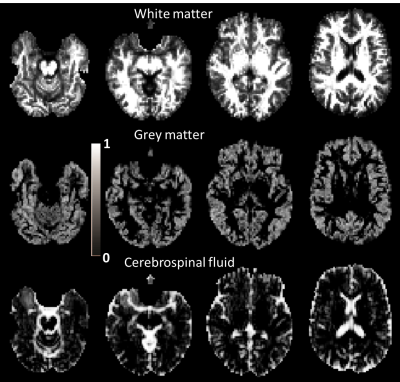 |
Damped Richardson-Lucy deconvolution for multi-shell diffusion MRI
Fenghua Guo, Alexander Leemans, Max Viergever, Flavio Dell'acqua, Alberto De Luca
The damped Richardson-Lucy (DRL) algorithm is a popular spherical deconvolution technique to quantify fiber orientation distributions from single-shell brain diffusion MRI (dMRI) data. Thanks to the progress of acquisition hardware, it is becoming increasingly common to acquire multi-shell dMRI data, which has the potential, to deliver additional information on the microstructure of tissues. In this work we extended the DRL framework to accommodate multi-shell data while accounting for multiple tissue types in the brain, to reduce partial volume contamination on the main FODs. The approach was tested on two dataset and proved to be stable over different acquisition schemes.
|
|
1555.
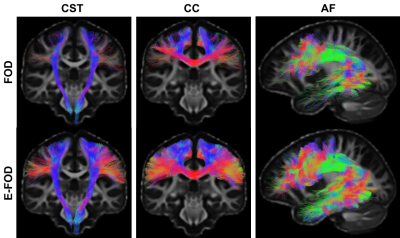 |
Bundle-specific tractography using voxel-wise orientation priors
Francois Rheault, Etienne St-Onge, Quentin Chenot, Laurent Petit, Maxime Descoteaux
Diffusion tractography allows the investigation of white matter (WM) pathways of interest. However, to cover the full spatial extent of the desired bundles, tractography requires a large amount of streamlines (millions) to be generated. In this work, we developed a bundle-specific tractography algorithm using voxel-wise orientation priors. Our method aims to be more efficient than a classical whole brain tractography and increase the quality of virtual WM dissection.
|
|
1556.
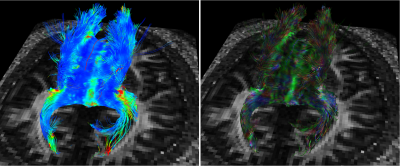 |
Exploring Local Geometric Structure of Fiber Tracts Using Tract-Based Director Field Analysis
Jian Cheng, Tao Liu, Feng Shi, Ruiliang Bai, Jicong Zhang, Haogang Zhu, Dacheng Tao, Peter Basser
Inspired by distortion analysis of liquid crystals [1], we propose a novel mathematical framework, called tract-based director field analysis (TDFA), to explore the local geometric structure of fiber tracts after tractography. TDFA provides 6 scalar indices along tracts to quantify local orientational dispersion and orientational distortion (splay, bend, and twist) of fiber tracts. To our knowledge, this is the first work to quantify "splay", "bend" and "twist" of fiber tracts, although the three terms have been widely used to qualitatively describe the complexity of fiber tracts for about 20 years [2]. Synthetic and real data experiments demonstrate the effectiveness of the proposed scalar indices.
|
|
1557.
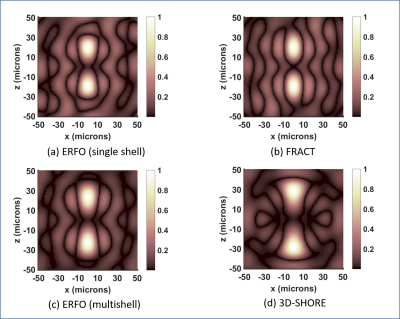 |
ERFO: Improved ODF estimation by combining machine learning with linear estimation theory
Divya Varadarajan, Justin Haldar
Hiqh-quality diffusion tractography depends on the accurate estimation of orientation distribution functions (ODFs). Existing estimation methods often use modeling assumptions that are violated by real data, lack theoretical characterization, and/or are only applicable to a narrow class of q-space sampling patterns. As a result, existing approaches may be suboptimal. This work proposes a novel ODF estimation approach that learns a linear ODF estimator from training data. The approach can be applied to arbitrary q-space sampling schemes, has strong theoretical justification, and it can be shown that the trained estimators will generalize to new settings they weren’t trained for.
|
|
1558.
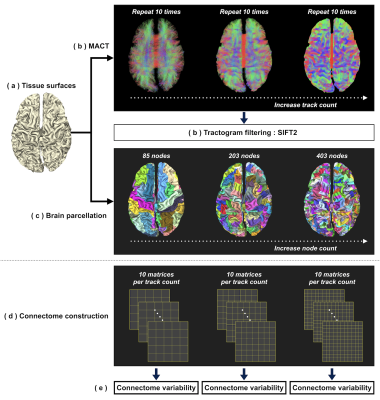 |
Investigating the streamline count required for reproducible structural connectome construction across a range of brain parcellation resolutions
Chun-Hung Yeh, Robert Smith, Xiaoyun Liang, Fernando Calamante, Alan Connelly
This study systematically investigates a fundamental question for tractogram-based connectomics research: for a given resolution of brain parcellation, how many streamlines are required for reproducible connectome construction? We incorporate state-of-the-art tractography techniques with surface parcellation schemes of multiple granularities to investigate the influence of streamline count on the connectome variability. Our results suggest that selecting an appropriate number of streamlines is crucial for global and per-edge variability of the connectome, revealing important implications for subsequent network analysis and inferences. Methods that investigate structural connectivity with different brain parcellation resolutions should benefit from the experimental workflow and outcomes of this study.
|
 |
1559.
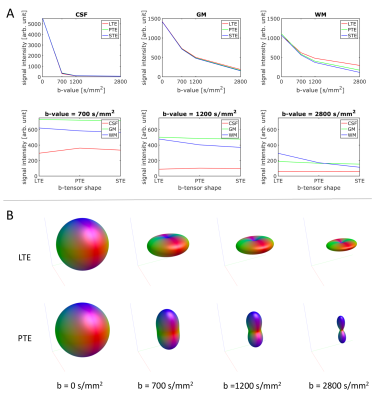 |
Spherical deconvolution of diffusion MRI data with tensor-valued encodings
Ben Jeurissen, Filip Szczepankiewicz
Multi-tissue constrained spherical deconvolution (MT-CSD) exploits the characteristic b-value dependency of each tissue type to estimate both the apparent tissue densities and the full white matter (WM) fiber orientation distribution function from diffusion MRI data. In this work, we extend the MT-CSD approach to account for data acquired with nonlinear and multiple b-tensor shapes and show that multiple b-tensor shapes can provide a new means of contrast between tissue types, in particular between gray matter and WM. Our approach provides high-quality apparent tissue density maps and high-quality fiber tracking from data with multiple b-tensor shapes, even with sparse q-space samplings.
|
|
1560.
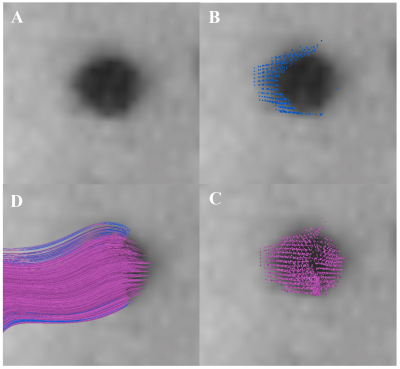 |
Free Water Elimination Improves Tractography Through Multiple Sclerosis Lesions
Brittany Gilchrist, Sidong Liu, Chenyu Wang, Ofer Pasternak, Yuyi You, Alexander Klistorner
Axonal loss within chronic MS lesions is typically accompanied by increase of extra-cellular space. Reduction of anisotropy caused by this excessive extra-cellular water may limit the ability of tractography techniques to accurately detect fibre bundles. The aim of this study was to examine if application of free water elimination (FWE) algorithm may improve deterministic tractography through MS lesions. We show that elimination of free water markedly increases detection of lesional fibre bundles. While this effect was observed in the majority of lesions, it was more apparent in lesions with small initial number of fibres and in lesions categorised as severely damaged.
|
|
1561.
 |
Is removal of weak connections necessary for dense weighted structural connectomes?
Oren Civier, Robert Smith, Chun-Hung Yeh, Alan Connelly, Fernando Calamante
Recent advances in tractography enable the generation of weighted structural connectomes where connection strengths are biologically meaningful. However, use of probabilistic tracking algorithms leads to dense graphs with many low-strength connections, many of which may be considered erroneous. Historically, the existence of such false positives necessitated thresholding of weak connections; this was especially relevant when constructing binary connectomes. Here we show that in dense weighted structural connectomes, the contribution of weak connections to network metrics is negligible and, thus, their removal is not necessary; indeed, the confounds introduced by an arbitrary cut-off value may in fact render this process undesirable.
|
|
1562.
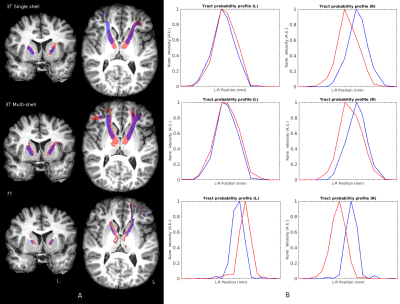 |
Angular versus spatial resolution in tractography for deep brain stimulation in psychiatry
Luka Liebrand, Guido van Wingen, Damiaan Denys, Matthan Caan
Deep brain stimulation of the ventral part of the anterior limb of the internal capsule (vALIC) could potentially benefit from tractography-guided targeting, since it contains two major fiber bundles. In order to develop a diffusion-weighted sequence that has the greatest bundle specificity within the vALIC, we compared tractography results from a single-shell 3T sequence with multi-shell 3T and high-resolution 7T sequences. Although the multi-shell sequence showed superior SNR, it did not allow increased bundle discernibility in the vALIC. The high-resolution sequence showed more anatomical detail, with more radially constrained tractography, and proved superior for separating the two bundles.
|
|
1563.
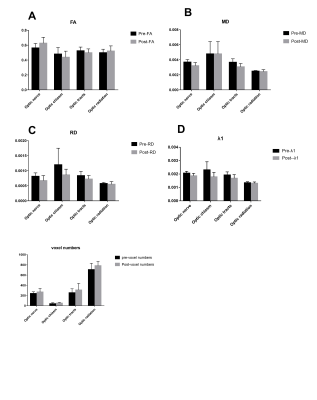 |
A preliminary application of the diffusion tensor imaging in estimating the functional and structural recovery of the visual pathway in Dysthyroid Optic Neuropathy patients after intravenous methylprednisolone pulse therapy.
ping liu, jing zhang
The management of DON (dysfunction optic neuropathy) is complex, an effective method to reflect the response of treatment is indispensable. We use the MRI-DTI combine d with DtiStudio software to assess the visual pathway changes in DON patients pre and post intravenous methylprednisolone pulse therapy. The results did demonstrate the improvement of visual pathway. The DTI can be regarded as a reliable tool to assess and follow up DON patients during therapy.
|
|
1564.
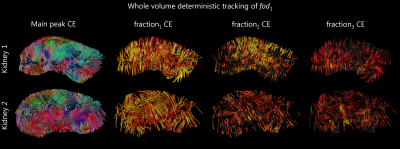 |
A multi-shell self-calibrating Richardson-Lucy deconvolution approach for the simultaneous quantification of ODF and tissue properties of different diffusion domains in the kidneys.
Alberto De Luca, Martijn Froeling, Alexander Leemans
The advent of multi-shell diffusion MRI (dMRI) offers a viable substrate to apply deconvolution profiles in tissues characterized by partial volume of multiple diffusion domains, as the kidneys. In this work we present a modified damped Richardson-Lucy (mdRL) algorithm to perform spherical deconvolution over multiple diffusion domains. This method does not need to define a prior response function, which is dynamically estimated for each voxel, and allows to compute a fiber orientation distribution as well as relevant scalar metrics, as mean diffusivity and fractional anisotropy, for each diffusion domain. Applicability on two sample datasets is demonstrated as proof of concept.
|
|
1565.
 |
Automatic reconstruction of cortico-striato-thalamo-cortical loops with application to obsessive-compulsive disorder
Dogu Baran Aydogan, David Thylur, Junyan Wang, Yuchun Tang, Janet Sobell, James Knowles, Yonggang Shi
Cortico-striato-thalamo-cortical (CSTC) loops are thought to play critical roles in the pathophysiology of several brain disorders. Despite the widespread evidence of CSTC circuits' crucial roles in brain disorders, a systematic approach to map their fiber pathways is missing. In order to advance our understanding on these critical circuits and how they are related to brain disorders, we propose a fully automatic approach for the in-vivo reconstruction based on diffusion MRI tractography. To demonstrate our approach, we studied MRI data from 19 patients with obsessive-compulsive disorder and 15 controls. Our approach enables in-dept analysis of the individual connections and also the full CSTC networks of the motor and lateral orbitofrontal loops.
|
|
1566.
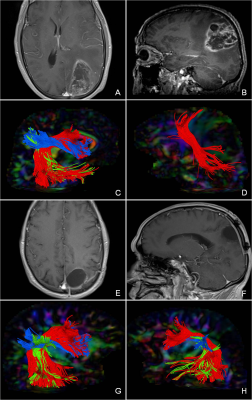 |
Predictive Value of Two-tensor Unscented Kalman Filter Tractography in the Reconstruction of the Arcuate Fasciculus (AF) in Patients with Gliomas Involving Eloquent Language Areas
Jing Yan, Jingliang Cheng, Shaoyu Wang, Xianzhi Liu
This study aimed to preliminarily investigate the postoperative changes of AF in glioma patients detected by two-tensor UKF tractography from the perspective of the usefulness as a reference for postoperative recovery of language functions. The postoperative changes of AF were evaluated chronologically in relation to postoperative changes in language functions after surgery. Our study preliminarily shows that postoperative changes in the long segment of the left AF detected by two-tensor UKF tractography may be a predicting factor for postoperative language functional outcomes. Postoperative changes in the long and posterior segment of the left AF may be related with the language comprehending and repeating ability in glioma patients.
|
|
1567.
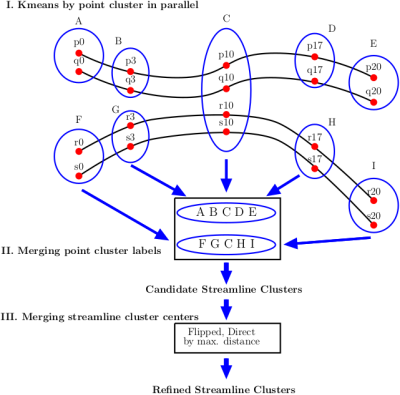 |
Clustering of tractography datasets based on streamline point distribution
Alexis Sánchez, Cecilia Hernández, Cyril Poupon, Jean-François Mangin, Pamela Guevara
We propose a fiber clustering algorithm composed by several steps, with the objective of representing the whole dataset by a small set of cluster centroids. First, a clustering is performed separately for a subset of points within the streamlines. The obtained point clusters are then used to regroup the fibers having common point clusters. Next, fiber clusters are filtered out by size and finally regroup using a quick merge based on a maximum Euclidean distance. A reduced set of regular and thin clusters is finally obtained. In contrast to previous works, the proposed method is only based on streamline structure.
|
|
1568.
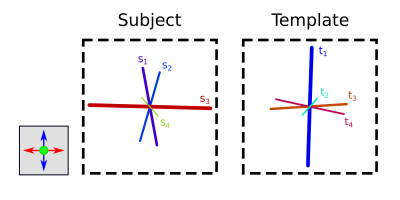 |
Mitigating the effects of imperfect fixel correspondence in Fixel-Based Analysis
Robert Smith, Alan Connelly
A requisite step in performing a Fixel-Based Analysis (FBA) is the determination of "fixel correspondence", which defines how discrete fibre elements (fixels) for a particular subject map to the fixels defined in each voxel in template space. The method used thus far for this purpose - simply selecting the subject fixel that best aligns with the template fixel - fails to take into consideration the possibility for substantial variations in fixel segmentation across subjects. We propose a more sophisticated algorithm for determining fixel correspondence, which better accounts for differences in fixel segmentation, and demonstrate how this reduces the variance observed in fixel data across healthy controls.
|
|
1569.
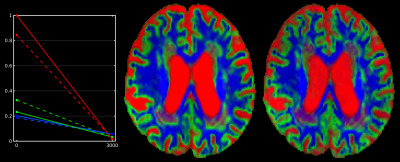 |
Accuracy of response function estimation algorithms for 3-tissue spherical deconvolution of diverse quality diffusion MRI data
Thijs Dhollander, David Raffelt, Alan Connelly
Multi-shell multi-tissue constrained spherical deconvolution (MSMT-CSD) and single-shell 3-tissue CSD (SS3T-CSD) resolve white matter (WM) fibre orientation distributions and grey matter (GM) and CSF tissue compartments by deconvolving WM, GM and CSF response functions from the diffusion MRI data. To estimate these response functions from the data itself, a T1-based method was originally proposed. Recently, an unsupervised DWI-based method that doesn't rely on a co-registered T1-weighted image was also introduced. We evaluated the performance of both methods on high-quality HCP-data and clinical-quality single-shell data of an elderly patient with extensive lesions. The DWI-based method was more accurate in both scenarios.
|
|
1570.
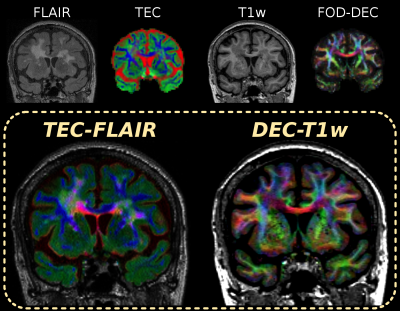 |
Tissue-Encoded Colour Fluid-Attenuated Inversion Recovery (TEC-FLAIR) map: contrast fusion designed for improved characterisation of white matter lesion heterogeneity
Thijs Dhollander, Remika Mito, Alan Connelly
FLAIR MR images feature striking contrast, allowing easy identification of white matter hyperintense lesions. While such lesions have been explained by a range of microstructural characteristics, FLAIR itself doesn't provide specificity to distinguish these heterogeneous origins. 3-tissue CSD techniques resolve white matter (WM), grey matter (GM) and CSF compartments. In lesions, GM-like and CSF-like diffusion-weighted signals have been hypothesised to be related to certain origins, e.g. gliosis or increased interstitial fluid. We propose a fusion of 3-tissue encoded colours and FLAIR via panchromatic sharpening techniques, designed for improved characterisation of white matter lesion heterogeneity.
|
|
1571.
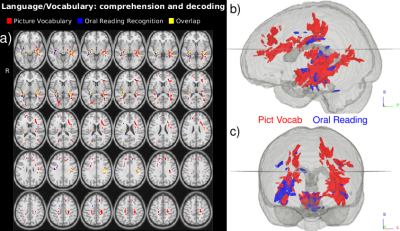 |
Linking neurocognitive measures with whole brain structure using Diffusion ODFs in the HCP dataset
Steven Baete, Ying-Chia Lin, Jingyun Chen, Ricardo Otazo, Fernando Boada
Higher dimensional diffusion protocols are now routinely acquired in large-scale studies. While these diffusion data sets contain a wealth of information about white matter architecture, this information is not fully exploited when their dimensionality is reduced to simplify statistical correlations with neurocognitive markers over the whole brain. To overcome this limitation, we analyze the full Orientation Distribution Function (ODF) at each voxel using a Low-Rank plus Sparse decomposition to identify key ODF features. We use this approach to link neurocognitive measures to brain structure in a cohort of healthy Human Connectome Project volunteers.
|
|
1572.
 |
7T DIFFUSION MRI DATA QUALITY FROM 3T SCANNER DATA
Suheyla Cetin Karayumak, Marek Kubicki, Yogesh Rathi
Diffusion MRI (dMRI) data obtained from a 7T scanner has novel and improved microstructural tissue information missing from data acquired on 3T scanners. In this work, we propose to use deep Convolutional Neural Networks (CNN) that use rotation invariant spherical harmonic (RISH) features to map the dMRI data (the raw signal) between scanners without changing the fiber orientation. We validate our algorithm on 40 Human Connectome Project (HCP) subjects with scans on both 3T and 7T (10 training + 30 test). Our preliminary results on 30 test subjects shows that CNN can indeed reliably obtain 7T dMRI data quality from 3T scans.
|
|
1573.
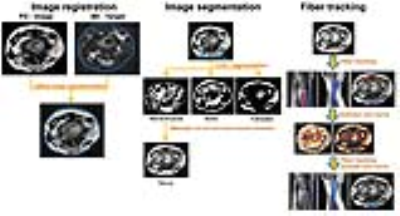 |
Pipeline for post-processing peripheral nerve DTI
Tina Jeon, Jerome Maller, Maggie Fung, Darryl Sneag
The purpose of the study is to evaluate and formalize a post-processing pipeline for DTI of the peripheral nerves using existing open source software suites. Our method integrates image registration, nerve segmentation, and DTI fiber tracking using the FMRIB software library (FSL) and MRtrix3, two popular software suites primarily used in the brain. 6 normal volunteers/patients and 9 nerves were analyzed and image quality was assessed. Using this protocol, image quality significantly improved in addition reducing processing time to 10 minutes using a semi-automated method.
|
|
Diffusion MRI: Signal Reconstruction & Representation
Traditional Poster
Diffusion
Tuesday, 19 June 2018
| Exhibition Hall 1574-1612 |
08:15 - 10:15 |
|
1574.
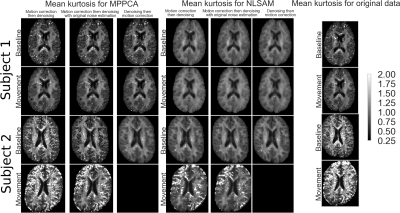 |
Investigating noise distribution changes after motion correction and its effects on subsequent diffusion MRI processing
Samuel St-Jean, Alberto De Luca, Max Viergever, Alexander Leemans
The quantification of diffusion MRI assumes the absence of motion and anatomical correspondence between diffusion sensitizing factors. To investigate the impact of processing order between motion correction and two denoising methods, we evaluated DKI and NODDI derived maps. Using repeated scans acquired with and without voluntary motion, three processing orders were compared. Results show that processing order moderately influences NODDI maps. However, two of the three denoising strategies can reduce outliers in mean kurtosis between 28% and 59% when compared to motion correction only.
|
|
1575.
 |
Optimal b-value selection for IVIM-DWI: identification of pancreastic lesions based on entire-tumor
Jiali Li, Daoyu Hu, Zhen Li
The purpose of this paper is to explore the successful b-value combination of IVIM-DWI that maximizes the diagnostic efficiency of parameters in differenting pancreatic cancer and normal tissues. IVIM parameters were measured by different b value combinations, and then the diagnostic performance of each significant parameter in identificating tumors and normal tissues was calculated and compared between different combinations. The results show that in different b value combinations, the diagnostic efficiency of the parameters are also different. The final conclusion is that b value combination of 0-1700 may be the best selection in clinical practice.
|
|
1576.
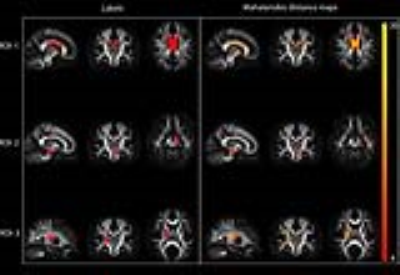 |
Voxel-wise Mahalanobis Distance (MaD-Vox): a multivariate approach to single subject analysis
Jose Guerrero, Douglas Dean III, Nagesh Adluru, Andrew Alexander
A voxel-wise multivariate analysis based on the Mahalanobis distance is presented. Upon implementation on simulated DTI data, the method demonstrates the ability to detect regions of pathology at an individual level with respect to a reference healthy control group. This multivariate approach could enhance the clinical value of diffusion weighted MRI in the assessment of individual patients with highly spatially heterogeneous brain conditions such as traumatic brain injury or autism spectrum disorder.
|
|
1577.
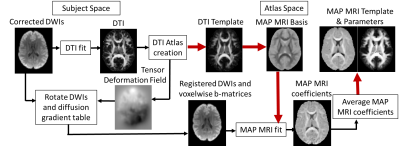 |
Anatomical atlas of MAP MRI-derived 3D diffusion propagators and microstructural parameters
Alexandru Avram, Adam Bernstein, M. Okan Irfanoglu, Amber Simmons, Martin Cota, Neville Gai, Neekita Jikaria, Anita Moses, Christine Turtzo, Lawrence Latour, Dzung Pham, John Butman, Peter Basser
We describe the construction of an anatomical template of 3D probability distributions water molecule displacements in tissues (i.e., diffusion propagators) measured with MAP MRI in a population of healthy volunteers. From the template of 3D diffusion propagators, we compute normative values of MAP MRI microstructural parameters and visualize the orientational characteristics of water net displacement profiles using orientation distribution functions (ODFs). This atlas could provide a reference for protocol development in longitudinal and multi-center studies, and for clinical studies seeking to detect and characterize subtle microstructural changes, such as those occurring in mild traumatic brain injury (mTBI), or metastatic cancer.
|
|
1578.
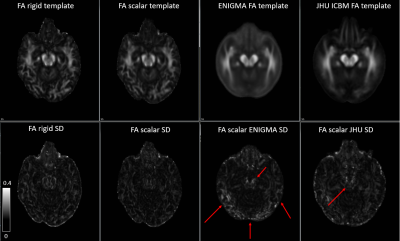 |
Spatial normalization of individual fractional anisotropy (FA) maps to widely used population templates for analysis can increase variability and create spurious differences in the measured FA values
Amritha Nayak, Elisabeth Wilde, Brian Taylor, CENC Neuroimaging Core Investigators, Laura Reyes, Carlo Pierpaoli
In this study we evaluate the effects of spatial normalization of individual fractional anisotropy (FA) maps to widely used population templates for analysis and its introduction of variability, creating spurious differences in the measured FA values.
|
|
1579.
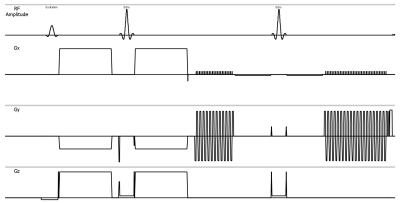 |
Clinical assessment of simultaneous diffusion tensor imaging and T2 relaxometry of lumbar nerve roots in patients with low back pain
Takayuki Sakai, Masami Yoneyama, Tosiaki Miyati, Atsuya Watanabe, Eunju Kim, Noriyuki Yanagawa
We developed a single-shot dual-echo EPI-DTI sequence (Diffusion-Relaxation Matrix: DRM) that can simultaneously provide the diffusion tensor parameters and T2 values. The purpose of this study was to investigate the clinical feasibility of DRM for the lumbar nerve roots in patients with low back pain. FA values were negatively correlated with each quantitative value. Prolongation of T2 values were observed in case of abnormally enlarged nerve roots. Therefore,simultaneous acquisition of diffusion tensor imaging and T2 map by using DRM technique might be able to evaluate the extent of nerve disorders more accurately.
|
|
1580.
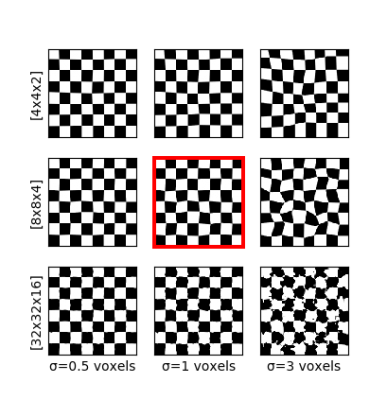 |
q-Space Deep Learning for Alzheimer’s Disease Diagnosis: Global Prediction and Weakly-Supervised Localization
Vladimir Golkov, Phillip Swazinna, Marcel Schmitt, Qadeer Khan, Chantal Tax, Marat Serahlazau, Francesco Pasa, Franz Pfeiffer, Geert Biessels, Alexander Leemans, Daniel Cremers
Most diffusion MRI approaches rely on comparably long scan time and a suboptimal processing pipeline with handcrafted physical/mathematical representations. They can be outperformed by recent handcrafted-representation-free methods. For instance, q-space deep learning (q-DL) allows unprecedentedly short scan times and optimized voxel-wise tissue characterization. We reformulate q-DL such that it estimates global (i.e. scan-wise rather than voxel-wise) information. We use this formulation to distinguish Alzheimer’s disease (AD) patients from healthy controls based solely on raw q-space data without handcrafted representations such as DTI. Classification quality is very promising. Weakly-supervised localization techniques indicate that the neural network attends to AD-relevant brain areas.
|
|
1581.
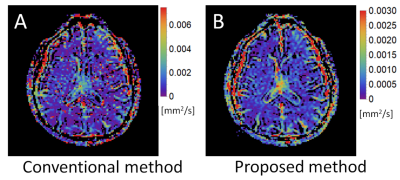 |
A method to estimate the product of perfusion fraction f and pseudodiffusion coefficient Dp of IVIM without estimating f and Dp
Eizou Umezawa, Masahiro Kawasaki, Yukiko Sonoda, Takashi Fukuba, Kazuhiro Murayama, Kazuki Takano, Masayuki Yamada, Toshiyuki Onodera, Masahiro Ida
IVIM analysis can provide the perfusion fraction f and the pseudodiffusion coefficient D* or Dp in addition to the diffusion parameters. The product of f and D* is known to relate to cerebral blood flow. Recently, a higher diagnostic performance of fD* than f and D* has been reported. We propose a method to estimate fDp without estimating f and Dp using DKI analysis. The DKI based IVIM analysis can be implemented easily and provides fDp values with a high degree of precision.
|
|
1582.
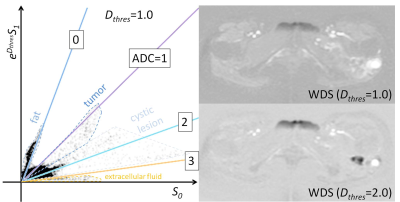 |
Histogram Analysis of Diffusion Weighted Image for Body Tumors
Manabu Arai, Koichi Oshio, Shigeo Okuda, Masahiro Jinzaki
Weighted diffusion subtraction (WDS) is a new imaging tool which may be useful for estimating the tissue characteristics within a voxel. In this study, DWI histogram (low b vs. high b) was generated and referred to WDS. On the histogram, the data distribution represents the tissue composition with blurring caused by partial volume. DWI histogram can visualize the relationship between T2WI (low b value DWI) and WDS.
|
|
1583.
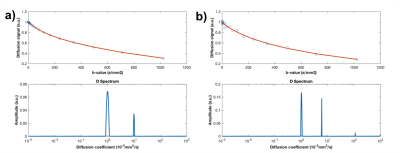 |
Regularized nonnegative least-square fitting for intravoxel incoherent motion data processing: a simulation study
André Paschoal, Renata Leoni, Fernando Paiva
Fitting model plays a crucial role in the analysis of intravoxel incoherent motion (IVIM) data due to limited number of points and to typical noisy data. Also, injured tissues can change the diffusion coefficient (D) value so that the number of D that contributes to total signal might be unknown. A possible solution for this problem is the nonnegative least-square (NNLS) fitting. This study aimed to evaluate the impact of the parameters used in the fitting and its applicability to simulated IVIM signal data processing.
|
|
1584.
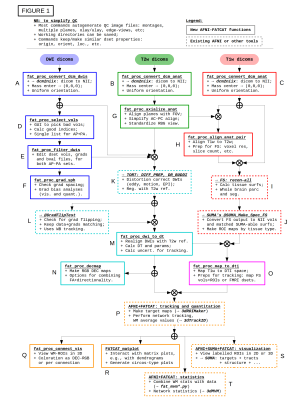 |
New analysis and visualization tools AFNI-FATCAT (and implementing other software)
Paul Taylor, Justin Rajendra, Amritha Nayak, M. Okan Irfanoglu, Daniel Glen, Richard Reynolds
The typical size of MRI data sets being processed for a study is rapidly increasing, particularly with the growth of publicly available data sets and “big data” strategies for approaching problems. This produces a dual need in analysis: having scriptable and reproducible pipelines for analysis, as well as having a method for visualizing data both during intermediate steps and for final results presentation. Here, we describe new AFNI-FATCAT tools that provides a succinct set of processing steps for a full DTI analysis pipeline, from DICOM conversion to tractography and statistical anlyses; these tools create QC images and quantitative checks at each step for pipeline evaluation.
|
|
1585.
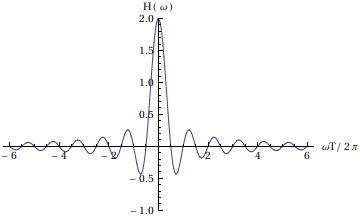 |
A review of the oscillating-gradient spin-echo signal model: Does a finite gradient duration alter
Jeff Kershaw, Takayuki Obata
The oscillating gradient spin-echo (OGSE) sequence has emerged as a promising diffusion-weighted imaging (DWI) technique for probing in vivo tissue microstructure. However, due to the finite duration of the diffusion gradients, there are some aspects of the signal model that should be considered in more detail. This work re-examines the derivation of the OGSE method to better understand how the properties of the selected MPG are reflected in the signal equation.
|
|
1586.
 |
Group Analysis of Healthy Aging Microstructural Integrity Parameters
Maíra Pinto, Antonio Santos, Carlos Salmon
The aim of this work is to compare FA and AFD as integrity parameter of white matter between groups of different ages to evaluate which areas of the white matter are affected in its fiber composition in the healthy aging process, and to evaluate if it happens in a global or specific manner. The results show that the largest decreases in FA and AFD occur in the brain of the elderly (over 60 years) due to more advanced axonal degeneration. AFD seems to show complementary information for understanding the white matter integrity alterations throughout the lifespan.
|
|
1587.
 |
Diffusion exchange spectroscopic imaging of the spinal cord
Dan Benjamini, Michal Komlosh, Peter Basser
Diffusion exchange spectroscopy (DEXSY) is successfully used in conjunction with imaging on the spinal cord, and with excellent prospects for preclinical and clinical applications. DESXY is a model-free approach to measure water migration between and among distinct microenvironments. The time dependency of water migration from the intra- and extracellular microdomains indicates that different regions within gray or white matter exhibit different exchange kinetics, and points to the importance of the spatial scale of this heterogeneity.
|
|
1588.
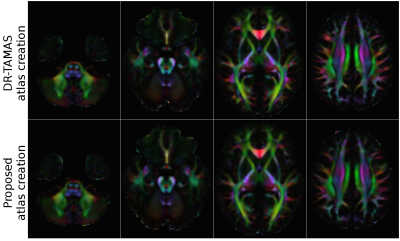 |
A Novel Strategy For Morphologically Faithful Registration and Template Creation for Diffusion MRI Data
M. Okan Irfanoglu, Neda Sadeghi, Carlo Pierpaoli, Moebius Syndrome Research Consortium
Spatial alignment of diffusion tensor MRI (DTI) data is of fundamental importance for voxelwise statistical analysis and creation of population specific atlases of diffusion MRI metrics. Most available DTI-based spatial normalization algorithms emphasize alignment of anisotropic structures and disregard the quality of alignment for gray matter and CSF-filled regions. Additionally, standard atlas creation strategies using these registration tools do not generate templates that are morphologically representative of average features of the population. In this work, we propose a new DTI-based registration and atlas creation method that aims to overcome these challenges.
|
|
1589.
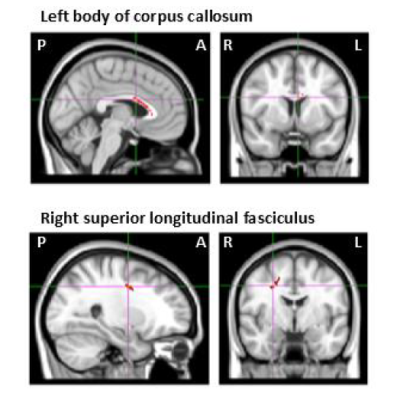 |
Reproducibility of Diffusion Tensor Imaging Data between Morning and Evening Scans
Domitille Dempuré, Jia Fan, André van der Kouwe, Ernesta Meintjes, A. Alhamud
Diffusion Tensor Imaging (DTI) is widely used to study brain white matter integrity. However, instability of the MRI scanner including heating of the iron plates in the shim trays or physiological changes during the day may influence DTI indices. The aim of this work was to evaluate DTI parameters through scans performed at two different times of the day, early morning and late afternoon, and repeated over six days. The results showed that DTI data acquired at different times of day differed, as mean diffusivity was higher in the morning than the evening.
|
|
1590.
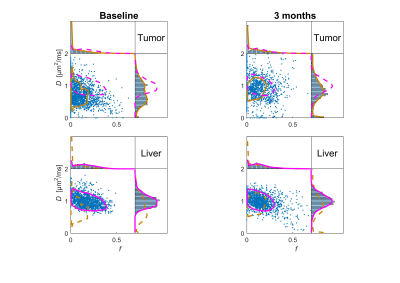 |
IVIM D and f - Optimal estimation technique and their potential for tissue differentiation
Oscar Jalnefjord, Mats Andersson, Mikael Montelius, Anna-Karin Elf, Viktor Johanson, Johanna Svensson, Göran Starck, Maria Ljungberg
IVIM parameter estimation restricted to D and f (avoiding D*) has gained increased popularity. In this study we show that the commonly used segmented fitting approach is preferable. We also show that differentiation between tumor and healthy liver tissue is substantially enhanced by the combined use of D and f.
|
|
1591.
 |
The influence of gradient nonlinearity on spherical deconvolution approaches: to correct or not to correct?
Fenghua Guo, Greg Parker, Alberto De Luca, Derek Jones, Max Viergever, Alexander Leemans, Chantal Tax
Gradient non-linearities affects diffusion weighted imaging (DWI) as it can result in geometric distortions and spatially varying b-values and gradient directions. The effect is more severe at high gradient strengths. Spherical deconvolution, in particular, relies on a spherical sampling of q-space, which might be affected due to gradient nonlinearities. In this work, we explored the sensitivity of two widely used spherical deconvolution approaches to the gradient non-linearity effect by investigating FOD peak orientation deviations, and evaluate a modified version of DRL that can take into account spatially varying diffusion gradients and weighting. Monte-Carlo simulations and two datasets from the HCP project were used for evaluation.
|
|
1592.
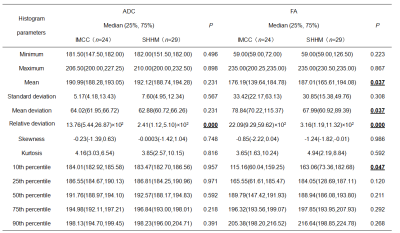 |
Value of Whole-Tumor Histogram Analysis of Diffusion Tensor Imaging in Differentiating Intrahepatic Mass-forming Cholangiocarcinoma and Solitary Hypovascular Hepatic Metastases
Ying Zhao, Ailian Liu, Lihua Chen, Lizhi Xie, Ye Li
Diffusion tensor imaging (DTI) is an imaging modality that detects the microstructural and pathological changes of organisms according to the diffusive characteristics of water molecules in the tissues. MR histogram analysis reflects the tumor heterogeneity. In the current study, histogram analysis of DTI was demonstrated to be capable to differentiate mass-forming cholangiocarcinoma and solitary hypovascular hepatic metastases, which can provide quantitative information for further clinical diagnosis.
|
|
1593.
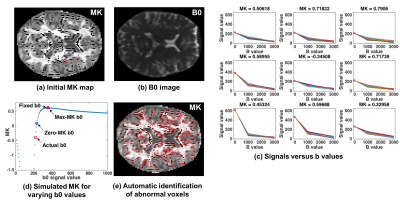 |
Characterization and Correction of Abnormally Low Mean Kurtosis Values
Fan Zhang, Lipeng Ning, Lauren O'Donnell, Ofer Pasternak
Diffusion kurtosis imaging (DKI) often yields abnormally low mean kurtosis (MK) values that are physically and/or biologically implausible. We aim to characterize the relationship between abnormally low MK and baseline (b0) values. We show that too low b0 signals explain abnormally low MK values. We propose an automatic and threshold free approach for the identification of low MK voxels, along with a correction strategy based on adaptive smoothing. Our results suggest that modifying the b0 is sufficient to resolve the vast majority of low MK values, and is preferred over two other popular correction methods.
|
|
1594.
 |
A novel method for the detection of the number of compartments in diffusion MRI data
Emma Metcalfe-Smith, Niloufar Zarinabad, Jan Novak, Hamid Dehghani, Andrew Peet
There is a need for a method that can detect the number of components within multi b-value diffusion-weighted imaging. In particular, this would aid in the identification and correction of partial volume effects (PVE) within the brain. A PVE model was simulated to contain varying ratios of cerebrospinal fluid and white matter. Multi-exponential fitting methods were applied and found to be unsuccessful in identifying the number of components within the model. A novel fitting method, the Autoregressive Discrete Acquisition Points Transformation, was applied to simulations. Following manipulation through the discrete Z-domain, the number of components were correctly identified.
|
|
1595.
 |
Multicompartment modelling of diffusion-weighted MRI data with no prior assumptions
Emma Metcalfe-Smith, Niloufar Zarinabad, Jan Novak, Hamid Dehghani, Andrew Peet
Multi-compartment modelling of Diffusion-Weighted MRI data can provide additional diffusion related parameters. However, to ensure meaningful parameters are attained, multi-compartment models have to make several assumptions prior to fitting, including initial parameter values and multi-step fitting procedures. The novel Autoregressive Discrete Acquisition Points Transformation (ADAPT) method was applied to in vivo data. ADAPT demonstrated that it could infer the number of compartments within the data. When 1- and 2-compartment ADAPT models were investigated, the ADAPT coefficients were found to correlate with the parameters attained by the Apparent Diffusion Coefficient (ADC) and the Intravoxel Incoherent Motion (IVIM) models.
|
|
1596.
 |
An efficient regularization method for diffusion MAP-MRI estimation
Hsu Yung-Chin, Tseng Wen-Yih
In the study, we proposed a regularization method for MAP-MRI estimation, called ReMAP. This method includes a regularization term in the cost functional in order to penalize the coefficients. The penalty is a simple diagonal matrix with entries determined only by the order of the Hermite functions, where higher order functions take more penalization, therefore, this method is easy to implement. In addition, ReMAP outperforms MAP-MRI in both estimation efficiency and accuracy, revealing that the regularization term is crucial for a robust estimation. Therefore, ReMAP is an improved version of MAP-MRI and would be beneficial for clinical studies.
|
|
1597.
 |
Are Intravoxel Incoherent Motion and Dynamic Contrast-Enhanced Perfusion Parameters Related in Glioblastomas?
Nicholas Majtenyi, Thanh Nguyen, Gerd Melkus, Ryan Gotfrit, Gregory Cron, Ian Cameron
Intravoxel incoherent motion (IVIM) is an MR-based diffusion-weighted imaging technique that can measure both diffusion and perfusion. Currently, no link has been established between the perfusion parameters obtained from IVIM to those from dynamic contrast-enhanced (DCE)-MRI, particularly in the human brain. This study determined that no correlation exists between these two perfusion measurement techniques in patients with glioblastomas. This indicates that these two imaging techniques measure two separate effects; however, IVIM may be able to provide complementary, additional perfusion information that can potentially aid clinical diagnoses when used in conjunction with DCE-MRI parameters.
|
|
1598.
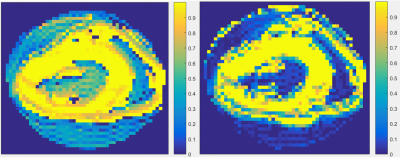 |
A non-Gaussian bi-exponential diffusion model with CUSP74 sampling for improved myocardial helix angle quantification and segmentation.
Cyril Tous, Alistair Young, Beau Pontre
The non-Gaussianity of diffusion at high b-value, leads to poor estimates of fast diffusion components when using diffusion models that assume Gaussian diffusion distributions. Including the diffusion kurtosis in a bi-exponential model allows better quantification of the partial volume effects when large b-values are used. This study investigates how this improved model can provide a better estimate of the helix angle in fixed heart specimens.
|
|
1599.
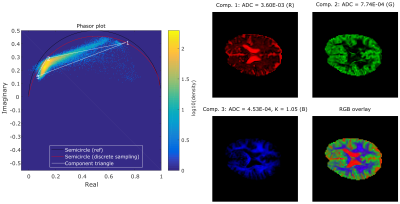 |
Where's my water? Untangling the diffusion signal using the phasor representation
Michael van Rijssel, Martijn Froeling, Josien Pluim
The recently proposed phasor representation and associated unmixing method allow separation of multi-exponentially decaying signals. This method has achieved promising results on diffusion MRI data and boasts sub-second analysis of full datasets on regular desktop PCs. This work investigates the noise propagation properties of this method and the influence of misplacing the vertex of a component in phasor space when performing unmixing. Results indicate that the phasor method is feasible and that the influence of component misplacement is systematic, but smaller than the errors due to noise at regular diffusion MR signal-to-noise-ratio levels.
|
|
1600.
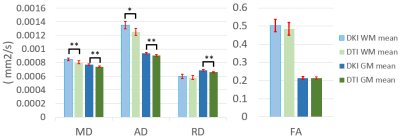 |
Intra- and inter-subject variability of diffusivity by DTI and DKI: An small animal study on 7T
Hung-Yu Fu, Wei-Cheng Lee, Sheng-Min Huang, Shin-Lei Peng, Kung-Chu Ho, Fu-Nien Wang
Diffusivity can be acquired by both DTI and DKI model on the same set of images. To investigate intra- and inter-subject variability of DKI and DTI derived diffusivities, five Sprague- Dawley rats were scanned on a 7T small animal scanner. In intra-subject variability test, lower coefficients of variation are found on DKI derived parameters. In inter-subject analysis, higher values were estimated by DKI in mean diffusivity, axial diffusivity, and radial diffusivity. The CNR between white matter and gray matter of these parameters are also better with DKI. However, the CNR of FA is higher with DTI than with DKI
|
|
1601.
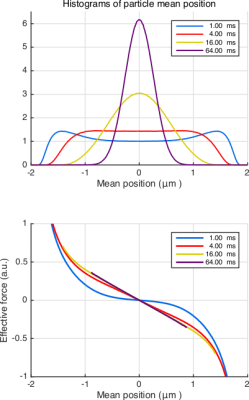 |
Effective potential for MR measurements of restricted diffusion
Evren Özarslan, Cem Yolcu, Magnus Herberthson, Carl-Fredrik Westin, Hans Knutsson
The compartmentalized structure of biological tissues demands a representation of individual compartments and a description of diffusion within them. We identified a quadratic potential energy profile, recently studied in-depth by Yolcu et al. (Phys Rev E, 93, 052602, 2016), as the effective energy landscape for restricted diffusion as far as gradient waveforms featuring long pulses are concerned. Our simulations suggest that the stochastic effective force on the center-of-mass position is approximately linear, thus providing further support for the Hookean effective force model.
|
|
1602.
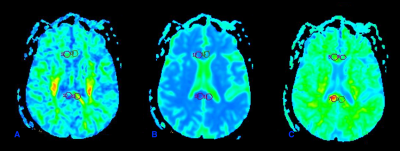 |
The diagnostic values of DTI and DKI techniques in degeneration of corpus callosum of chronic alcoholism
Ke-ning Xu, Guo-shi LYU, Lizhi Xie
Chronic alcoholism is a common disease, and many patients are often associated with corpus callosal degeneration. In this study, the values of fractional anisotropy (FA) and apparent diffusion coefficient (ADC), diffusion tensor imaging (DTI) and the mean kurtosis (MK) values in diffusion kurtosis imaging (DKI) were used to analyze chronic alcoholism with corpus callus (MBD) patients, to explore the diagnostic value of these three parameters in MBD patients. Receiver operating characteristic curve(ROC)analysis of the parameters of the diagnosis of the disease. The results showed that FA is better than ADC and MK, and the sensitivity and specificity are better.
|
|
1603.
 |
Comparison of intravoxel incoherent motion DWI, diffusion kurtosis imaging, and conventional DWI in predicting the chemotherapeutic response of colorectal liver metastases: preliminary experience
Huan Zhang, Wenhua Li, Robert Grimm, Caixia Fu, Xu Yan, Tong Tong
The aim of this study was to compare the performance of pre-treatment intravoxel incoherent motion DWI (IVIM-DWI), diffusion kurtosis imaging (DKI), and conventional DWI for predicting the chemotherapeutic response in patients with colorectal liver metastases (CRLMs). The results indicates that they are all potentially useful for predicting the chemotherapeutic response of CRLMs, with mean diffusion derived from DKI having the best performance.
|
|
1604.
 |
Quantitative Comparison of Multiple High Angular Resolution Diffusion Imaging Techniques for Myocardium
Sifangyuan Wang, Lihui Wang, Jian Zhang, Rongpin Wang, Xinfeng Liu, Yuemin Zhu
We compared quantitatively three commonly used HARDI schemes for describing the myocardium structure in a unified frame-work. One pig heart was firstly scanned with 256 diffusion directions, and then the diffusion ODFs of q-ball imaging (QBI), diffusion spectrum imaging (DSI) and generalized q-space imaging (GQI) were reconstructed respectively, from which the myocardiac fiber orientations and the diffusion metrics were finally extracted and compared. The results show that the cardiac fiber crossing locations, crossing numbers, and the generalized fractional anisotropy detected by three schemes are totally different.
|
|
1605.
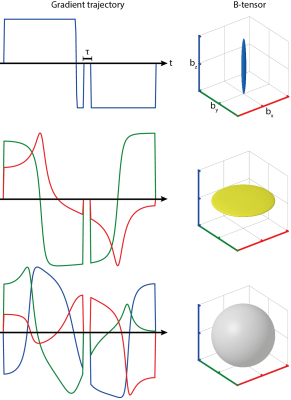 |
Diffusion gradient performance optimization for B-tensor encoded q-space trajectory imaging of the human brain
Jan Martin, Andreas Wetscherek, Lars Müller, Tristan Kuder, Michael Uder, Bernhard Hensel, Frederik Laun
q-Space trajectory imaging is a recently introduced approach for determining microscopic diffusion tensor properties like μFA and orientation coherence. To create the necessary higher order B-tensors special gradient trajectories are needed. The initial implementation of q-space trajectory imaging was based on magic-angle-spinning of the q-vector, and required echo times of 160 ms for b-values of 2000 s/mm2. In the current abstract, numerically optimized gradient trajectories were implemented, which reduced the required echo time to 115 ms. The resulting parameter maps benefited from the increase in signal-to-noise ratio.
|
|
1606.
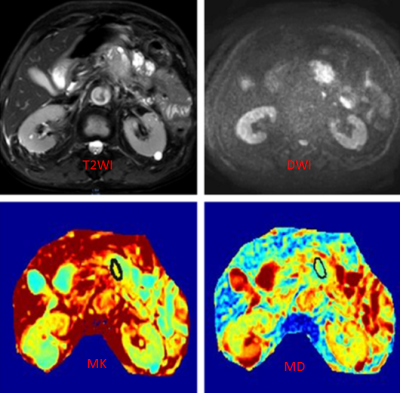 |
Application value of DKI in grading of pancreatic cancer
Meiying Yan, Xiaoqi Wang, Rengen Xu
Tumor cells and the complex micro-environment would lead to restricted the water molecules diffusion, in the form of non-Gaussian distribution at space, and diffusion kurtosis imaging (DKI)(1) describes the degree of non-Gaussian distribution, and it has shown to reflect more sensitive diffusion information comparing with regular diffusion weighted image(DWI)(2). It was reported that DKI helped to classify tumors like astrocytomas (3). However, there is challenges on the DKI application mostly due to low SNR in pancreas diffusion images and motion artifacts. pancreatic cancer is a malignant pancreatic tumor,and the recent prognosis of patients with pancreatic cancer is determined by the histopathological grade of tumor. Herein, we reported the investigation on applying DKI to differentiate the histological grade of pancreatic cancer.,by assessing DKI parameters.
|
|
1607.
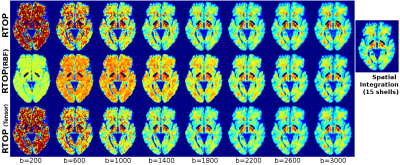 |
Return-to-the-origin probability calculation in single shell acquisitions
Santiago Aja-Fernandez, Antonio Tristan-Vega, Malwina Molendowska, Tomasz Pieciak, Rodrigo de Luis-Garcia
One of the problems of estimating q-space scalar measures is the need of a high number of samples in the q-space in order to properly reconstruct the diffusion signal without aliasing. In this work we propose an alternative method to estimate the return-to-origin probability (RTOP) from a single shell acquisition using a prior assumption over the diffusion signal. The method provides significant structural information even for single shell acquisitions with moderate b-values.
|
|
1608.
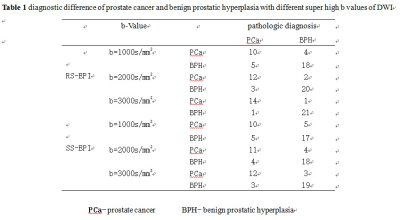 |
Comparison between readout segmented diffusion weighted imaging and single shot echo planar imaging for differential diagnosis of prostate cancer
Chuangbo YANG, Qi YANG, Nan YU, Hui TAN, Wei WEI, Guangming MA, Shaoyu WANG, Shenglin LI
Readout segmented diffusion weighted imaging (Rs-EPI) with ultra-high b value ( 1000?2000?3000s/mm2) have high sensitivity , specificity, PPV and NPV in the differential diagnosis of prostate cancer than single shot echo planar imaging (SS-EPI) does.
|
|
1609.
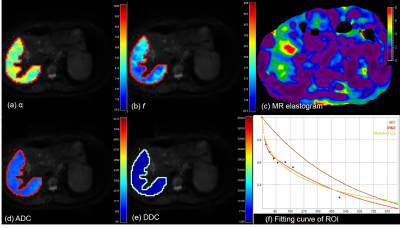 |
Comparison of three diffusion models: monoexponential vs. intravoxel incoherent vs. stretched model
Jeong Hee Yoon, Eunju Kim, Jeong Min Lee
A diffusion heterogeneity index (α) derived from a stretched exponential model may serve as a more sensitive parameter for hepatic fibrosis compared with paramters from mono-or bi-exponential diffusion weighted imaging (DWI).
|
|
1610.
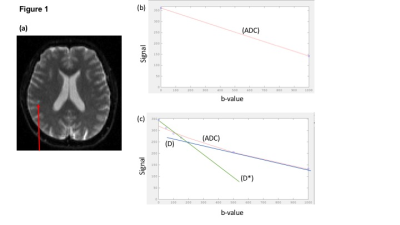 |
Multi-platform reproducibility of advanced diffusion weighted MRI parameters in phantoms and healthy volunteers
Shah Islam, Matthew Grech-Sollars, Matthew Orton, Lesley Honeyfield, Eric Aboagye, Adam Waldman
Quantitative diffusion imaging has an evolving role in tumour characterisation and disease monitoring. Most clinical DWI sequences use ADC derived from two b-values. Multiple b-value acquisition allows further biologically-relevant diffusion components to be interrogated using bi-, multi- and stretched exponential models; these require validation for application in multicentre trials. This study compared the reproducibility of ADC, IVIM and stretched exponential parameters across MRI platforms in two phantoms and healthy volunteers. Our initial results suggest highly reproducibility of all measured parameters in phantoms, and of ADC and IVIM in healthy brains. Stretched exponential data appear less reproducible in vivo.
|
|
1611.
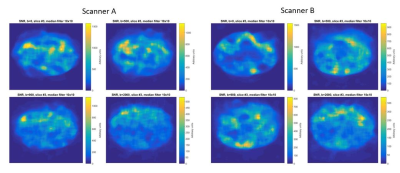 |
Diffusion Weighted Signal Variation with Body Phantom
Raj Attariwala, Wayne Picker, Amy Chambers, Mikko Maatta
DWI body phantom development and signal to noise calculation based on RSNA QIBA protocol guidelines for identically configured MRI machines shows machine variability and resultant ADC calculation error propagation.
|
|
1612.
 |
Non-Gaussian diffusion restriction effects in intravoxel incoherent motion imaging acquired at b-values below 1000 $$$\tt s/mm^{2}$$$
Hajime Tamura, Hideki Ota, Tatsuo Nagasaka, Naoko Mori, Shunji Mugikura
To know how much the intravoxel incoherent motion (IVIM) parameters deduced by a bi-exponential model are affected by neglecting non-Gaussian diffusion restriction effects, we performed Monte-Carlo simulations: fitting the bi-exponential model to simulated data containing the diffusion restriction effects. The results showed that non-Gaussian diffusion restriction effects may considerably affect estimation of IVIM parameters even when data acquired with low b-values (b≤1000 s/mm2) are used. This should be taken into account when interpreting the results of IVIM analyses based on the bi-exponential model.
|
|
Diffusion MRI: Acquisition & Reconstruction
Traditional Poster
Diffusion
Tuesday, 19 June 2018
| Exhibition Hall 1613-1655 |
08:15 - 10:15 |
|
1613.
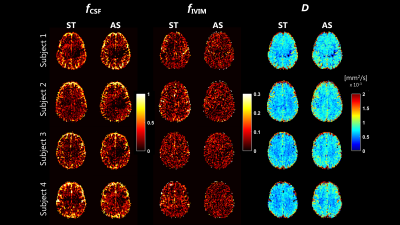 |
A comparison of multi-ADC and DTI fit metrics of diffusion MRI data acquired with Stejskal-Tanner and asymmetric bipolar gradients at identical echo time.
Alberto De Luca, Alexander Leemans, Martijn Froeling
Asymmetric-Bipolar (AS) gradients have been proposed in diffusion MRI (dMRI) experiments as alternative to Stejskal-Tanner (ST) gradients to achieve flow and motion-compensation. However, it remains unclear whether the gradient shape affects commonly derived metrics. Data at multiple diffusion-weightings was acquired on 4 subjects with ST and flow-compensated gradients, then fit with a multi-ADC model and DTI. Results showed that some metrics, as free water signal fraction and fractional anisotropy were comparable between AS and ST, whereas diffusion coefficients and perfusion fraction were remarkably different. Great care is suggested when comparing studies using different waveforms despite other identical acquisition parameters.
|
|
1614.
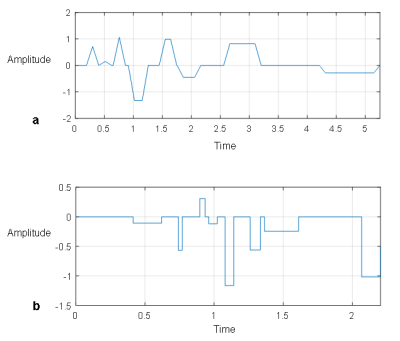 |
Motion Compensated, Optimized Diffusion Encoding (MODE) Gradient Waveforms
Waqas Majeed, Prateek Kalra, Arunark Kolipaka
We present a framework to obtain motion compensated diffusion encoding waveforms that are shorter than all diffusion encoding waveforms available to date. These waveforms can be obtained analytically. We successfully demonstrate the use of these waveforms for cardiac DWI.
|
|
1615.
 |
Optimal Diffusion-weighting Gradient Waveform Design (ODGD): Formulation and Experimental Validation
Óscar Peńa-Nogales, Yuxin Zhang, Rodrigo de Luis-Garcia, Santiago Aja-Fernandez, James Holmes, Diego Hernando
Diffusion-Weighted MRI often suffers from signal attenuation due to long TE, sensitivity to physiological motion, and dephasing due to concomitant gradients (CGs). These challenges complicate image interpretation and may introduce bias in quantitative diffusion measurements. Motion moment-nulled diffusion-weighting gradients have been proposed to compensate motion, however, they frequently result in high TE and suffer from CG effects. In this work, the Optimal Diffusion-weighting Gradient waveform Design method that overcomes limitations of state-of-the-art waveforms is revisited and validated in phantom and in-vivo experiments. These diffusion-weighting gradient waveforms reduce the TE and increase the SNR of state-of-the-art waveforms without and with CG-nulling.
|
|
1616.
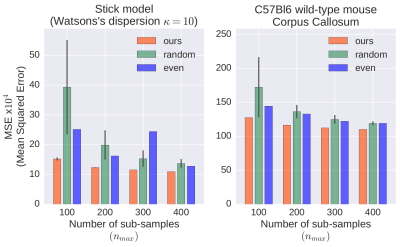 |
Spatio-Temporal dMRI Acquisition Design: Reducing the Number of Samples
Patryk Filipiak, Rutger Fick, Alexandra Petiet, Mathieu Santin, Anne-Charlotte Philippe, Stephane Lehericy, Rachid Deriche, Demian Wassermann
Acquisition time is a major limitation in recovering brain white matter microstructure with diffusion magnetic resonance imaging. Finding a sampling scheme that maximizes signal quality and satisfies given time constraints is NP-hard. Therefore, we propose a heuristic method based on genetic algorithm that finds sub-optimal solutions in reasonable time. Our diffusion model is defined in the $$$q\tau$$$-space, so that it captures both spacial and temporal phenomena. The experiments on synthetic data and in-vivo diffusion images of the C57Bl6 wild-type mouse corpus callosum reveal superiority of our approach over random sampling and even distribution in the $$$q\tau$$$-space.
|
|
1617.
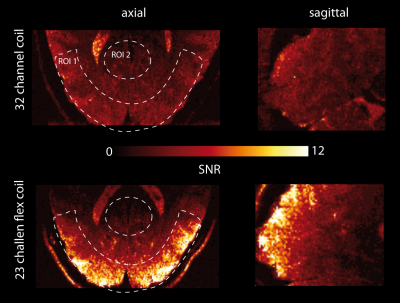 |
High resolution in vivo diffusion weighted imaging of the human occipital cortex: enabled by 300mT/m gradients and flexible radio-frequency surface coils.
Evgeniya Kirilina, Fakhereh Movahedian Attar, Luke Edwards, Kerrin Pine, Nikolaus Weiskopf
Information about intracortical fibers and connectivity can potentially be obtained using diffusion weighted imaging (DWI). However, in vivo intracortical DWI requires extraordinarily high spatial resolution. We demonstrate in vivo DWI imaging in the human occipital cortex with an isotropic resolution of 800 μm enabled by a high-performance 300 mT/m gradient system and flexible high-sensitivity RF receive coil optimized for cortical imaging. Robust detection of intracortical features was achieved in a reasonable scanning time. The described setup opens the exciting possibility to study intracortical connectomics in humans in vivo.
|
|
1618.
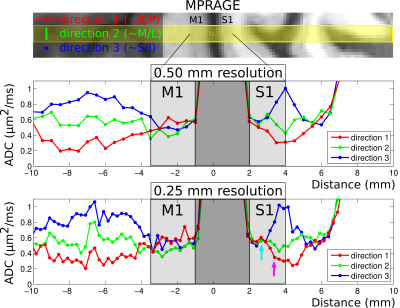 |
In-vivo line-scan diffusion MR at 250 micron inline resolution within human cerebral cortex at 7T
Mukund Balasubramanian, Robert Mulkern, Jeffrey Neil, Stephan Maier, Jonathan Polimeni
We used the line-scan technique to measure in-vivo diffusion at 7T within human primary somatosensory cortex (S1) and primary motor cortex (M1), achieving voxel sizes as low as 0.25 mm in the radial direction (i.e., orthogonal to the cortical surface). Our results are consistent with recent reports of predominantly tangential diffusion in S1 and, to a lesser extent, radial diffusion in M1; however, the smaller voxel sizes used in our study alleviate concerns regarding partial-volume effects and, perhaps more importantly, enable the study of fine-scale variations in diffusion structure across cortical layers.
|
|
1619.
 |
Evaluation of Monopolar Diffusion-Prepared TSE for Diffusion Imaging
Jialu Zhang, Xiufeng Li, Kamil Ugurbil, Anna Roe, Xiaotong Zhang, Dingxin Wang
EPI-based diffusion imaging methods are dominantly used, but suffer from susceptibility associated distortion and signal loss, making it challenging to achieve high-quality high-resolution diffusion imaging results. To overcome these challenges, we implemented monopolar diffusion preparation module for TSE sequence (DP-TSE) and evaluated the performance in comparison to readout segmented multi-shot echo planner (RESOLVE) sequence for diffusion weighted imaging (DWI). Our study results suggest that Diffusion-Prepared TSE is a promising alternative for distortion-free, high-resolution diffusion imaging with superior diffusion SNR.
|
|
1620.
 |
Comparison of different diffusion MRI acquisition protocols by tracking callosal motor pathways with deterministic and probabilistic fiber tracking algorithms
Meizhen Han, Jia-Hong Gao
High angular resolution diffusion MRI (HARDI), the most widely used method in in-vivo brain imaging experiments to delineate white matter pathways, has been found sufficient for resolving 2-way fiber crossings but unstable for detecting 3-way fiber crossings. Therefore, if more sensitive and accurate tractography is wanted, researchers need to use high b-value with multi-shell q-ball models, which can be time-consuming. In this study, we compared 3 diffusion MRI acquisition protocols by tracking callosal connections between motor areas with both probabilistic and deterministic fiber tracking algorithms and provided a new scheme for the future diffusion MRI experiment.
|
|
1621.
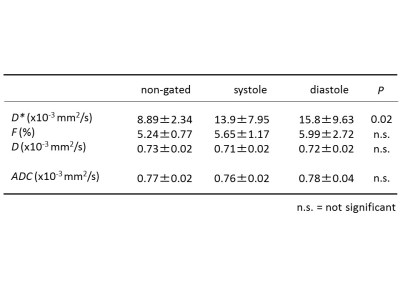 |
Optimization of b values and reproducibility of perfusion and diffusion parameters using IntraVoxel Incoherent Motion (IVIM) with peripheral pulse triggering
Yu Ueda, Minoru Hayashida, Koji Yoshida, Tomoyuki Okuaki, Katsuyoshi Ito, Makoto Obara, Marc Cauteren
To investigate the reproducibility of IVIM-derived parameters with peripheral pulse unit (PPU) triggering and optimized b values combination to decrease scan time, we assessed the reproducibility by calculating coefficient of variation (CV) for each parameter. Moreover, D* and F calculated with some b value patterns were compared to those with all b values using the Pearson correlation. Our results suggest that cardiac gating does not improve reproducibility of perfusion and diffusion parameter. F with only 4 b values (e.g. b=0-200-500-1000) can provide robust information on perfusion noninvasively with significantly shortened scan time.
|
|
1622.
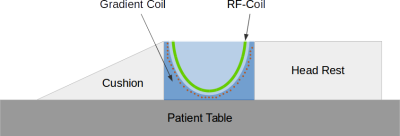 |
Impact of slew rates on the performance of a novel high-gradient breast diffusion probe
Theresa Palm, Jan Martin, Bernhard Hensel, Feng Jia, Maxim Zaitsev, Tristan Kuder, Mark Ladd, Michael Uder, Frederik Laun
Recent advances in gradient technology, in particular based on the use of local gradient coils, have increased the available gradient strength by almost an order of magnitude. In this context, the question arises what slew rates are required to translate the higher gradient amplitudes into the improved assessment of shorter diffusion times given a certain b-value. This work shows that slew rates are important in high-gradient diffusion experiments (G≥300 mT/m), in particular in low b-value applications (b≤1000 s/mm˛).
|
|
1623.
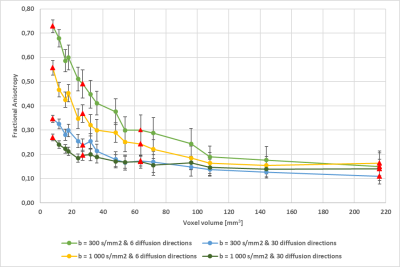 |
Low b-values and limited diffusion directions introduce bias in FA and MD that increases with decreasing voxel volumes.
Ofentse Noko, Stephen Jermy, Ali Alhamud, Ernesta Meintjes
Due to ECG triggering and breath hold techniques required to compensate for motion of the beating heart and respiration, acquisition times for cardiac diffusion tensor imaging (DTI) are limited. As such, lower b-values and fewer diffusion directions are typically used, together with larger slice thicknesses. This study aims to assess the impact of these changes on fractional anisotropy (FA) and mean diffusivity (MD) in a pineapple phantom. Smaller voxels were found to be more sensitive to changes in b-values and number of diffusion directions.
|
|
1624.
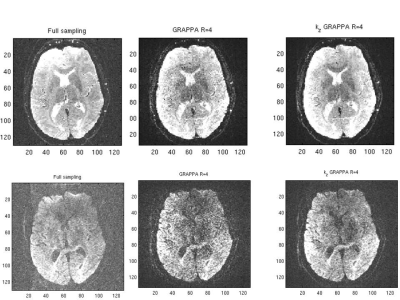 |
Progress in the use of SQUASHER for Diffusion weighted imaging
Steen Moeller, Sudhir Ramanna, Essa Yacoub, Mehmet Akcakaya
The applicability of SQUASHER to EPI, along with a kz-dependent reconstruction approach for highly-accelerated 3D segmented EPI in dMRI
|
|
1625.
 |
Shorter Acquisition Times for Diffusion-Weighted Imaging of the Human Spinal Cord with Simultaneous Acquisition of Multiple Inner Fields-of-View
Caspar Florin, Jürgen Finsterbusch
Inner field-of-view EPI is widely used for diffusion-weighted acquisitions of the human spinal cord. However, due to the high in-plane resolution required acquisition times to achieve a reasonable signal-to-noise ratio are usually rather long. In this study, inner-field-of-view EPI based on 2D-selectove RF excitations is accelerated with multiband excitations. Two different approaches are considered that differ with respect to the orientation of the 2DRF trajectory and whether side excitations must be suppressed or can be used to cover the bands excited and acquired simultaneously. Results obtained in the human brains stem and cervical spinal cord in vivo are presented.
|
|
1626.
 |
Anisotropic Diffusion Filter for Simultaneous Combination and Denoising of Multiple Acquisitions in DWI of the Spinal Cord
Sevgi Kafali, Cagri Aydinkarahaliloglu, Tolga Çukur, Emine Saritas
In diffusion weighted imaging (DWI), multiple acquisitions are acquired and averaged to attain a reasonable SNR level, especially for high spatial resolution or high b-value imaging. However, bulk or involuntary physiological motion during diffusion-sensitizing gradients alters the k-space, creating unpredictable global and/or local phases across multiple acquisitions. Therefore, direct complex averaging of these multiple acquisitions is prohibited. Here, we propose a reconstruction scheme based on modified anisotropic diffusion filtering, which starts with complex-valued acquisitions and corrects the phase issues while improving the SNR. The proposed reconstruction is demonstrated with in vivo DWI of the cervical spinal cord at 1.5T.
|
|
1627.
 |
Improvement of diffusion-weighted image quality by iShim toward realization of cervical spinal cord region QSI
Yoshifumi Sone, Zhouchen Lu, Junichi Hata, Daisuke Nakashima, Katsuya Maruyama, Alto Stemme, Takeo Nagura , Morio Matsumoto, Masaya Nakamura
Herein, we adopted diffusion-weighted imaging (DWI) with a high fat suppression effect and high signal-to-noise ratio (SNR) in the cervical region, where magnetic field inhomogeneity may occur, using integrated slice-by-slice shimming (iShim), which improves static magnetic field (B0) shimming accuracy. We examined spinal cord SNR and standard deviation in healthy volunteers and performed cervical DWI with the conventional B0 shimming method and iShim, respectively. Furthermore, to verify whether short TI inversion recovery (STIR) or water excitation (WE) was appropriate as a fat suppression method, we used DWI with a high SNR at the cervical region by combining iShim with WE.
|
|
1628.
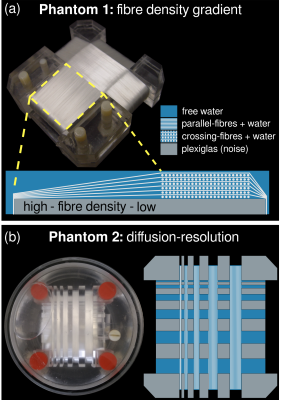 |
DTI-based free-water elimination with T2-weighting using dedicated anisotropic diffusion fibre phantoms
Ezequiel Farrher, Kuan-Hung Cho, Richard Buschbeck, Husan-Han Chiang, Ming-Jye Chen, Farida Grinberg, N. Jon Shah, Chang-Hoon Choi, Li-Wei Kuo
In this work we demonstrate the use of two dedicated anisotropic diffusion fibre phantoms for the study of free-water elimination DTI. In particular, we make use of the recently proposed approach in which an extra dimension to the diffusion weighting, namely transverse relaxation weighting, is added to the model.
|
|
1629.
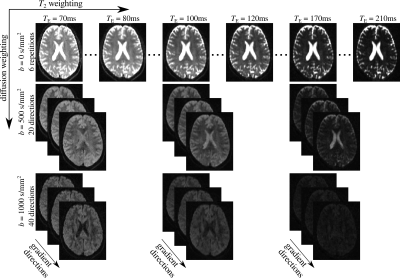 |
In vivo DTI-based free-water elimination with T2-weighting
Ezequiel Farrher, Richard Buschbeck, Chang-Hoon Choi, Li-Wei Kuo, Seong-Dae Yun, Farida Grinberg, N. Jon Shah
Free-water elimination allows one to reduce the bias in DTI metrics induced by partial-volume effects. Unfortunately the fitting problem for this model is ill-conditioned. However, it has been recently demonstrated that the introduction of a second dimension determined by the echo-time, leads to a well-conditioned fitting problem. In this work we investigate the experimental design and data analysis pipeline of such experiments in vivo.
|
|
1630.
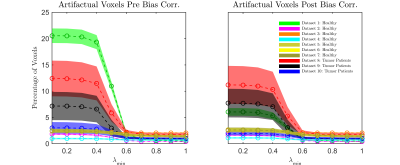 |
The Role of Bias Field Correction in the Free Water Elimination Problem
Drew Parker, Abdol Aziz Ould Ismail, Simon Alexander, Ragini Verma
Free water elimination (FWE) paradigms provide information about underlying pathology-induced tissue changes, based on a multi-compartment fit to the dMRI acquisition. Non-uniform intensity in MR signal, either due to coil or acquisition sequence, produces inhomogeneous tissue intensity profiles. This negatively affects FWE paradigms, producing artifactual multi-compartment fits. In this work, through extensive application on varied datasets, we demonstrate the effect of using bias field correction, an optimized non-uniform intensity normalization, on reducing artifacts in FWE and producing physiologically relevant maps. This suggests that bias correction should be maintained as an essential step in dMRI preprocessing for FWE.
|
|
1631.
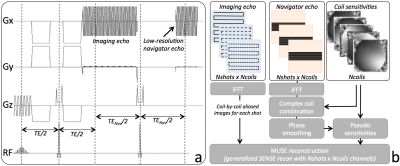 |
Navigated Multi-shot Diffusion-Weighted Imaging with Multiplexed Sensitivity Encoding
Valentina Taviani, Ann Shimakawa, Lloyd Estkowski, Arnaud Guidon, Ersin Bayram, Robert Peters
MUltiplexed Sensitivity Encoding (MUSE) has been successfully used to correct for motion-induced phase errors in multi-shot diffusion-weighted imaging. However, this technique relies heavily on parallel imaging (PI) and can result in residual aliasing and excessive noise amplification when the number of shots is similar to the number of receiver coil elements. We propose a navigated multi-shot approach with multiplexed sensitivity encoding to handle cases where the coil geometry would otherwise limit the maximum number of interleaves. We show that both PI and 2D-selective excitation pulses can be used to reduce the scan duration, while maintaining similar levels of distortion.
|
|
1632.
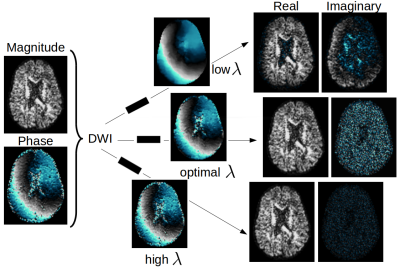 |
Automatic and Spatially Varying Phase Correction for Diffusion Weighted Images
Marco Pizzolato, Rachid Deriche
Phase Correction is a post-processing procedure exploiting the phase of magnetic resonance images in order to obtain real-valued images containing tissue contrast with additive Gaussian noise, as opposed to magnitude images which are typically affected by a bias due to the Rician distribution of noise. This bias is particularly relevant in Diffusion Weighted Images where the signal-to-noise ratio is intrinsically low. We propose a method for automatically assessing the optimal amount of required correction based on properties of the noise affecting the images: its variance and positional non-stationarity. We present results for diffusion metrics such as FA, AD, and MD.
|
|
1633.
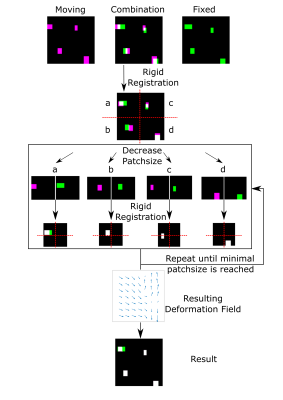 |
Image-based Multi-Scale Distortion Correction: Application to Diffusion Imaging
Lars Bielak, Hatice Bunea, Nicole Wiedenmann, Anca-Ligia Grosu, Michael Bock
This work presents an algorithm that calculates a distortion field to correct a geometrically distorted image using an anatomically precise reference image. The algorithm employs mutual information based rigid image registration with a pyramidal architecture. Validation was performed on simulated distortion fields and in vivo comparison to a measured B0-fieldmap.
|
|
1634.
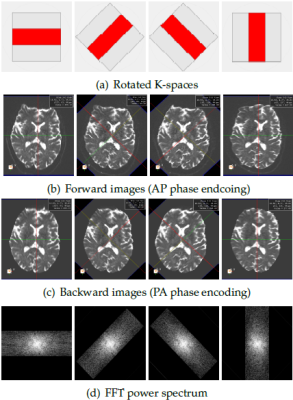 |
High Resolution Reconstruction of Diffusion Weighted Imaging Using EPI-Corrected Snapshots Acquired with Rotated K-spaces
Hengameh Mirzaalian, Benoit Scherrer, Onur Afacan, Ali Gholipour, Simon K. Warfield
We propose a non-Cartesian high resolution reconstruction of diffusion-weighted magnetic resonance imaging (DW-MRI) using multi-snapshots acquired with rotated K-spaces. Our technique boosts the signal level by reducing the echo time and by increasing voxel size for each snapshot. The final high resolution image is reconstructed by fusion of the snapshots, which were corrected for Echo-Planar-Imaging (EPI) distortions. We applied and evaluated different EPI correction methods. Through qualitative and quantitative evaluations based on in-vivo experiments, we showed that our protocol and image reconstruction technique leads to high spatial resolution and high signal-to-noise ratio DW-MRI.
|
|
1635.
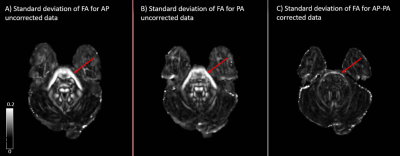 |
A living phantom study to evaluate the echo planar imaging (EPI) distortion correction effects in reducing inter-site variability
Amritha Nayak, Elizabeth Wilde, Brian Taylor, CENC Neuroimaging Core Investigators, Laura Reyes, Carlo Pierpaoli
In this study we evaluate the effect of echo planar imaging (EPI) distortion artifact as a contributing factor in inter-site variability. With living phantom data acquired with opposite phase encoding direction protocol (blipup-blipdown), we show the effectiveness of a robust EPI distortion correction method in reducing inter-site variability.
|
|
1636.
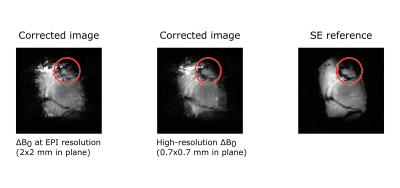 |
High-resolution off-resonance maps improve conformity between distortion-corrected EPI acquisitions and distortion-free references
Michael J van Rijssel, Frank Zijlstra, Peter R Seevinck, Peter R Luijten, Dennis W J Klomp, Josien P W Pluim
The majority of diffusion acquisitions is affected by geometrical distortions due to susceptibility induced off-resonance effects in the EPI readout. This hampers the use and effectiveness of these images in multiparametric cancer protocols, especially in lipid-rich environments such as the human breast where tissue interfaces cause large but local discontinuities. Preliminary results show that improvements upon existing correction techniques can be made by using high-resolution off-resonance information in distortion correction algorithms.
|
|
1637.
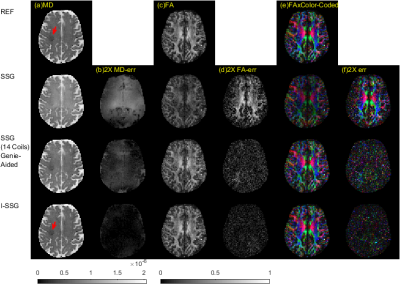 |
Effects of phase error on image reconstruction for simultaneous multi-slice readout-segmented diffusion MRI
SeyyedKazem HashemizadehKolowri, Rong-Rong Chen, Edward DiBella, Edward Hsu, Leslie Ying, Ganesh Adluru
In this work, we study the effect of phase errors on the quality of image reconstructions for simultaneous multi-slice (SMS) readout-segmented echo planar imaging (RS-EPI) acquisitions. We propose an iterative split slice-GRAPPA (I-SSG) algorithm to train improved kernels using estimated diffusion weighted images (DWIs) rather than baseline images. Results from stroke patients show that the proposed I-SSG algorithm produces consistently better reconstructions than the SSG algorithm in the presence of baseline phase errors.
|
|
1638.
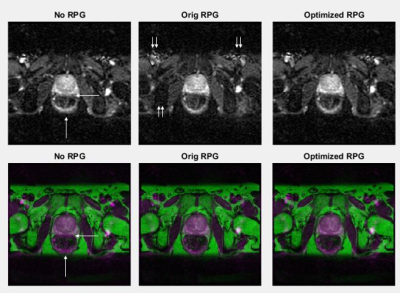 |
Distortion Correction using Reverse Polarity Gradient Method: Algorithm Optimization for Prostate Imaging using a Hybrid Weighting Metric
Maggie Fung, Pauline Worters, Ek Tsoon Tan, Arnaud Guidon, Ersin Bayram
Prostate Diffusion Weighted Echo Planar imaging (DW-EPI) routinely suffers from nonlinear geometric distortion due to B0 inhomogeneity. Although reverse phase-encoding polarity-based distortion correction method works well in the brain, the same technique causes artifacts in prostate DWI due to the low SNR nature of body DWI scans, and the inconsistency of image content between the reverse and forward polarity images. In this study, we showed that a hybrid weighting metric method could improve the distortion correction performance in prostate DWI.
|
|
1639.
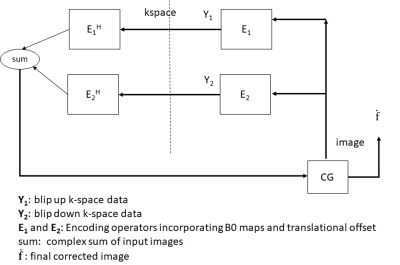 |
An integrated model-based framework for the correction of signal pile-up and translational offsets in prostate diffusion MRI
Muhammad Usman, Lebina Kakkar, Karin Shmueli, Simon Arridge, David Atkinson
Prostate diffusion EPI scans suffer from geometric distortions, signal pile-up and signal drop-out due to differences in susceptibility values at interface between prostate and rectal-air. In this work, an integrated model based framework is proposed that can correct for signal pile-up in regions of severe distortions and can compensate for any translational offsets that may exist between different scans. In-vivo validation of the proposed method is done in patients.
|
|
1640.
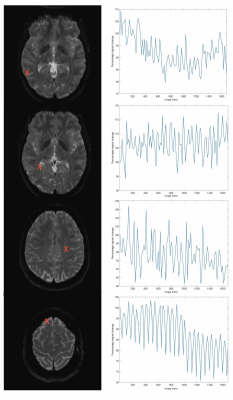 |
Spatially Varying Signal-Drift Correction in Diffusion MRI
Khoi Huynh, Geng Chen, Wei-Tang Chang, Weili Lin, Dinggang Shen, Pew-Thian Yap
The magnetic field in a MR scanner varies slightly in strength over time and causes the signal to drift. This drift can vary from voxel to voxel both in extent and direction. In this abstract, we show using diffusion MRI data that signal drift can be corrected more accurately when done locally than globally over the whole image volume1. For this purpose, we employ a non-parametric correction method using non-diffusion-weighted scans interspersed in the diffusion-weighted image series.
|
|
1641.
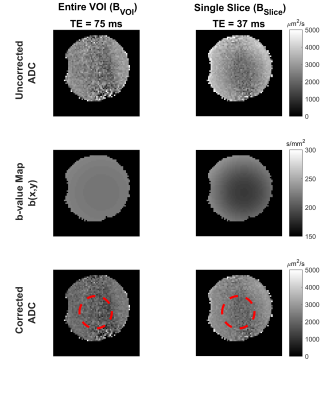 |
Local Optimization of Diffusion Encoding Gradients Using a Z-Gradient Array for Echo Time Reduction in DWI
Koray Ertan, Soheil Taraghinia, Emine Saritas, Ergin Atalar
Spatial dependency of the gradient fields can be dynamically optimized using a gradient array coils driven by independent gradient amplifiers. Such dynamic optimization allows to maximize gradient strengths inside a target volume such as slice rather than the entire VOI. Gradient linearity error constraints can also be relaxed to obtain higher gradient strengths. Higher gradient strength can be utilized as diffusion gradients for shorter diffusion durations and TEs for fixed b-value, which increases the SNR of the DWI. Nine channel z-gradient array is used to create optimized gradient fields, which lead to 50% reduction of TE in phantom experiments.
|
|
1642.
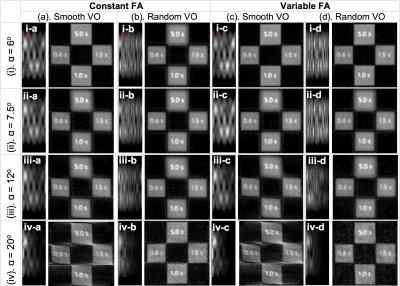 |
2D Single-Shot Radial Diffusion-Weighted Imaging free of geometric distortion and optimization of SNR using Variable Flip-Angle and Random View-Ordering
Kyle Jeong, Eun-Kee Jeong
The 2D ss-DWEPI is routinely used for in-vivo DW imaging, because of its immunity to motion-induced artifact, but prone to susceptibility-induced geometric distortion. We present a novel DWI technique using single-shot radial imaging, which produces DW images with minimal geometric distortion, no motion artifact, and with optimized SNR and reduced effect of undersampling radial streak artifact. Variable-flip angle (VFA) and random-view ordering (RVO) were implemented to improve the SNR and reduce the geometric distortion, respectively.
|
|
1643.
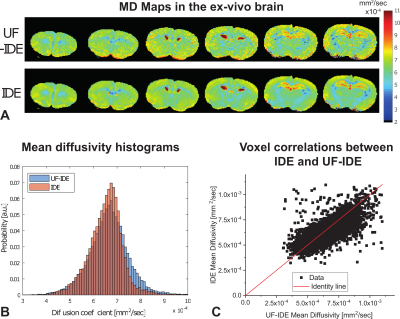 |
Single-scan Mapping of Mean Diffusivity Using the Incomplete Initial Nutation Diffusion Imaging (INDI) framework
Andrada Ianus, Noam Shemesh
Diffusion MRI techniques require at least two different acquisitions separated by a repetition time in order to map mean diffusivity. Thus, dynamic imaging techniques, such as diffusion functional MRI, which aim to measure rapid diffusivity changes, might provide results confounded by T2 changes over the repetition time. This study introduces and validates the INDI (incomplete initial nutation diffusion imaging) framework, which can be used to accelerate diffusion acquisition so that the reference and diffusion weighted images are acquired within a few tens of milliseconds of each other.
|
|
1644.
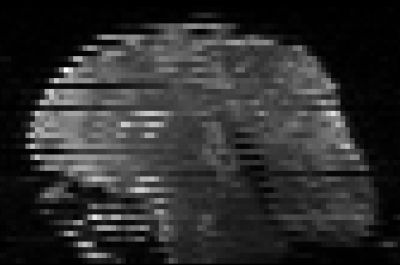 |
Removal or correction of volumes affected by bulk motion: impact on DTI and NODDI metrics
Kerstin Pannek, John Welsh, Jurgen Fripp, Joanne George, Paul Colditz, Roslyn Boyd, Stephen Rose
In difficult patient populations, the interleaved acquisition of diffusion weighted volumes often leads to images that are not self-consistent due to movement. Here, we investigated the effect of removing or correcting volumes with movement artefacts on the DTI measures FA and MD, as well as on NODDI measures. While removal of affected volumes is typically used, we found that a simple correction strategy leads to markedly lower bias and variability in all diffusion measures. Data that may need to be rejected entirely if volume removal is used, may be salvaged if correction is used.
|
|
1645.
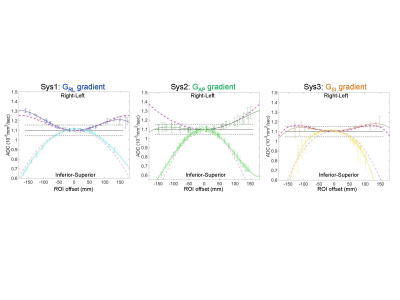 |
Quantifying deviations from gradient design in multi-platform longitudinal DWI QC for on-scanner correction of diffusion weighting bias
Dariya Malyarenko, Yuxi Pang, Lisa Wilmes, Ek Tan, Johan Tondeur, Ajit Devaraj, Julien Sénégas, Johannes Peeters, John Kirsch, Michael Jacobs, David Newitt, Thomas Chenevert
The most practical correction of nonuniform diffusion weighting due to gradient nonlinearity would use scanner-specific gradient design information similar to current mitigation of geometric image distortions. To check the feasibility of this approach in a multi-center, multi-scanner setting, longitudinal DWI quality control studies using a quantitative diffusion phantom were performed on representative MRI platforms in collaboration with three vendors. Here we report preliminary results for proposed descriptive metrics that adequately reflect the amount and source of deviations from system gradient design to guide implementation of comprehensive bias correction for quantitative DWI applications.
|
|
1646.
 |
Intravoxel Incoherent Motion (IVIM) Fingerprinting
Qiuting Wen, Li Feng, Kun Zhou, Yu-Chien Wu
Intravoxel incoherent motion (IVIM) imaging employs a bi-exponential diffusion model to estimate capillary contributions to the diffusion-weighted signal. Major challenges of IVIM are long acquisition time, long processing time, and image distortion associated with EPI acquisition. In this work, we proposed a novel framework for rapid and distortion-free IVIM imaging called IVIM-Fingerprinting. It employs a single-shot acquisition scheme and an advanced image reconstruction scheme in combination with the recently proposed concept of MR Fingerprinting. Its performance was demonstrated both for simulation and for in-vivo studies.
|
|
1647.
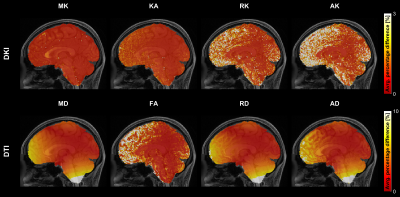 |
Investigating the effect of gradient nonlinearities on Diffusional Kurtosis Imaging parameters: Results from the Human Connectome Project
Hamed Y. Mesri, Szabolcs David, Max Viergever, Alexander Leemans
Gradient field nonlinearities in diffusion-weighted MRI may lead to systematic errors in the diffusion metrics. Despite previous works highlighting the adverse impact of gradient field nonuniformities on diffusion-weighted MRI, these effects are usually neglected and left uncorrected. In this work we use simulations and real data from the Human Connectome Project to investigate the effect of gradient field nonlinearities on the measures from Diffusional Kurtosis Imaging. Our results demonstrated that in general, the effect for the diffusion tensor metrics is larger than the effect for diffusional kurtosis metrics. However, the effect of the gradient nonlinearities on the kurtosis metrics should not be neglected.
|
|
1648.
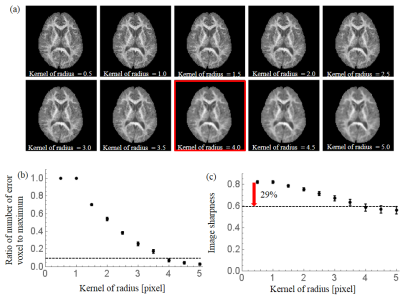 |
Error estimation and evaluation of spatial smoothing processing for diffusion kurtosis imaging
Suguru Yokosawa, Yoshitaka Bito, Hisaaki Ochi
DKI often suffers from error estimation such as unphysical negative kurtosis values which result in black voxels on mean kurtosis (MK) map. In this study, causes of the estimation error are investigated by using simulation. In addition, effect of smoothing processing is quantitatively evaluated in terms of reduction in estimation error and image sharpness. Our findings will be useful for clinical diagnosis using DKI.
|
|
1649.
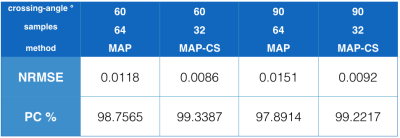 |
Improved diffusion propagator reconstruction using Hermite functions and compressed sensing
Gabriel Varela-Mattatall, Carlos Castillo-Passi, Joaquin Mura, Pablo Irarrazaval
Mean apparent propagator (MAP) reconstructs the diffusion pdf using a dictionary based on Hermite functions. The first element corresponds to a tensor approximation; and the following elements add non-gaussian components. To improve non-gaussian accuracy, one needs to increase the size of the dictionary, but it also increases the number of q-space samples for a robust optimisation. We propose the use of compressed sensing to efficiently increase the number of atoms in the dictionary by exploiting its sparsity for a better reconstruction.
|
|
1650.
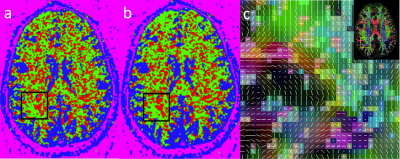 |
The Determination of Voxel Anisotropic Properties From Data of Low Agular Resolution Using Machine Learning Method and Compressed Sensing Reconstruction
Xuesong Li, Zhendong Niu, Zhangxuan Hu, Sen Song, Hua Guo
The estimation of voxel anisotropic properties from diffusion tensor imaging is critical for fiber tracking. Here machine learning was used to estimate the voxel anisotropic properties from undersampled data that were reconstructed by dictionary learning.
|
|
1651.
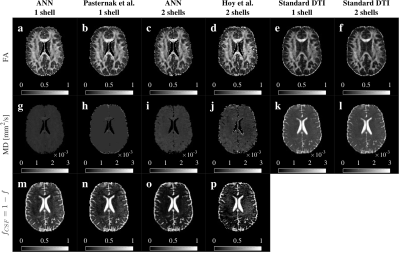 |
Deep learning with synthetic data for free water elimination in diffusion MRI
Miguel Molina-Romero, Pedro Gómez, Shadi Albarqouni, Jonathan Sperl, Marion Menzel, Bjoern Menze
Diffusion metrics are typically biased by Cerebrospinal fluid (CSF) contamination. In this work, we present a deep learning based solution to remove the CSF contribution. First, we train an artificial neural network (ANN) with synthetic data to estimate the tissue volume fraction. Second, we use the resulting network to predict estimates of the tissue volume fraction for real data, and use them to correct for CSF contamination. Results show corrected CSF contribution which, in turn, indicates that the tissue volume fraction can be estimated using this joint data generation and deep learning approach.
|
|
1652.
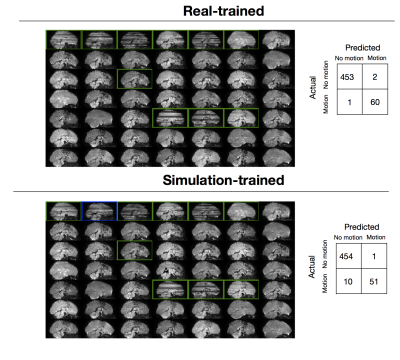 |
A supervised learning approach for diffusion MRI quality control with minimal training data
Mark Graham, Ivana Drobnjak, Hui Zhang
Quality control (QC) in diffusion-weighted MRI (DW-MRI) involves identifying problematic volumes in datasets. The current gold standard involves time-consuming manual inspection of data, and even supervised learning techniques that aim to replace the gold standard require manually labelled datasets for training. In this work we show the need for manual labelling can be greatly reduced by training a supervised classifier on realistic simulated data, and using a small amount of labelled data for a final calibration step. Such an approach may have applications in other image analysis tasks where labelled datasets are expensive or difficult to acquire.
|
|
1653.
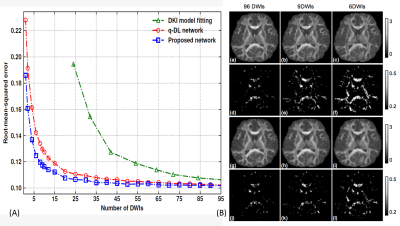 |
Efficient Reconstruction of Diffusion Kurtosis Imaging Based on a Hierarchical Convolutional Neural Network
Ting Gong, Hongjian He, Zhiwei Li, Zhichao Lin, Qiqi Tong, Chen Li, Yi Sun, Feng Yu, Jianhui Zhong
Diffusion kurtosis imaging (DKI) captures more complex microstructural properties than the widely used diffusion tensor imaging (DTI) but requires a longer acquisition time. To accelerate its acquisition, and thus facilitate its practical clinical use, a hierarchical convolution neural network (H_CNN) reconstruction method was proposed. The results showed that the H_CNN method provides efficient reconstruction of all eight DTI and DKI measures using as few as nine DWIs, with improved robustness against noise and the retention of fine structures, compared to artificial neural network-based methods. The H_CNN method potentially enables DKI clinical applications with an acquisition time of one minute.
|
|
1654.
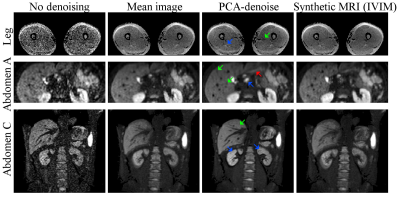 |
Principal component analysis for model-free denoising of multi b-value diffusion-weighted images
Oliver Gurney-Champion, David Collins, Mihaela Rata, Andreas Wetscherek, Uwe Oelfke, Kevin Harrington, Matthew Orton
We introduce principal component analyses (PCA) as a denoising technique for diffusion-weighted MRI (DWI) that is independent of the diffusion attenuation model. PCA denoises DWI data using only informative components while removing noisy ones. We show that it outperforms model-based denoising in simulations as well as in vivo. In simulations, PCA-denoising resulted in smaller systematic errors, while random errors were similar. In vivo, PCA-denoising rendered less noisy images and when motion was present, PCA recovered certain structures that were obscured by motion in model-based denoising. In conclusion, PCA-denoising is a powerful model-free tool for denoising DWI data.
|
|
1655.
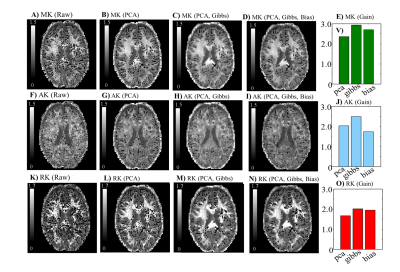 |
PCA denoising using random matrix theory provides an optimal compromise between noise suppression and preservation of non-Gaussian diffusion.
Rafael Neto Henriques, Marta Correia
Recent studies showed that PCA denoising algorithms using random matrix theory provide an optimal compromise between noise suppression and loss of anatomical information for standard diffusion measures and tractography approaches. In this study, we show that this algorithm seems also to optimally preserve the non-Gaussian diffusion properties. Several factors that influence the performance of the PCA denoising algorithm are also assessed, such as the spatial heterogeneity of diffusion parameters across neighbour voxels and different scanning protocols. Moreover, the compatibility of PCA denoising with Gibbs artefact suppression and noise bias correction is evaluated.
|
|
Diffusion MRI: Applications
Traditional Poster
Diffusion
Tuesday, 19 June 2018
| Exhibition Hall 1656-1675 |
08:15 - 10:15 |
|
1656.
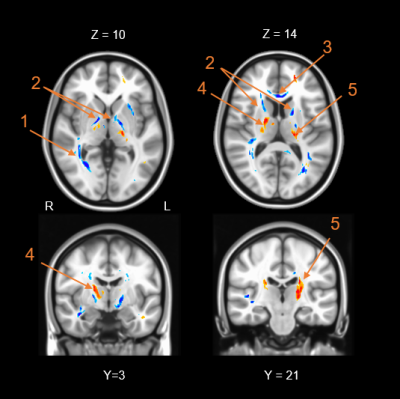 |
Diffusion MRI as a descriptive imaging marker of the pathogenesis of treatment-resistant depression.
Julie Coloigner, Jean-Marie Batail, Isabelle Corouge, Jean-Christophe Ferré, Dominique Drapier, Christian Barillot
Despite the extensive therapy options available for depression, treatment-resistant depression (TRD) occurs in 20-30% of depressed patients. . Consequently, identification of neural changes in TRD could support to better understand the mechanism of resistance and to improve the treatment of individual depressed patients. We aimed to investigate the white-matter microstructure in a sample of depressed patients in which response to treatment was subsequently evaluated 6 months after. Our findings suggest the abnormalities of the white-matter integrity in multiple white matter tracts, such as anterior limb of internal capsule and genu of corpus may play a role in the pathogenesis of treatment-resistant depression.
|
|
1657.
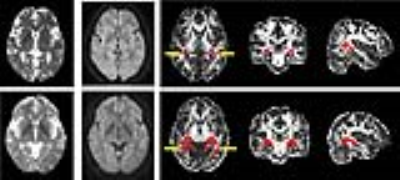 |
Diffusion tensor MR imaging of optic radiation in advanced bilateral glaucoma patients in comparison to normal control subjects
Chanon Ngamsombat, Thanakorn Chareankarunyuta, Prapaporn Pornwuthi, Panida Charnchaowanish, Yudthaphon Vichianin, Ngamkae Ruangvaravate, Shuo Zhang, Orasa Chawalparit
Glaucoma is a worldwide leading cause of irreversible vision loss characterized by degeneration of retinal ganglion cells. The damage can be found in visual pathway beyond retina and optic disc to visual cortex. Diffusion tensor MR imaging (DTI) is widely used for evaluation of early microstructural change in the brain parenchyma. Here we reported abnormal change of the optic radiation in advanced bilateral glaucoma patients using DTI as compared to the age-matched normal control subjects. The obtained DTI parameters may serve as potential quantitative imaging biomarkers to provide complementary indication of the disease condition in glaucoma.
|
|
1658.
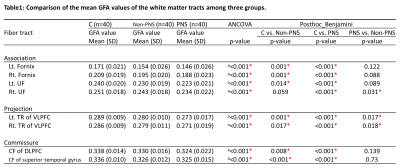 |
Altered white matter tracts in schizophrenia with persistent negative symptoms
Jing-Ying Huang, Chih-Min Liu, Tzung-Jeng Hwang, Yung-Chin Hsu, Hai-Gwo Hwu, Wen-Yih Tseng
This article aimed to investigate the alteration of white matter tracts in schizophrenia with persistent negative symptoms (PNS) in an attempt to identify white matter tracts that are characteristic of PNS. We performed diffusion spectrum imaging (DSI) and whole brain tract-based automatic analysis (TBAA) to compare the tract integrity among healthy controls, PNS and non-PNS groups. Our results showed that the right uncinate fasciculus and bilateral thalamic radiations of the ventral lateral prefrontal cortex are tract correlates of PNS.
|
|
1659.
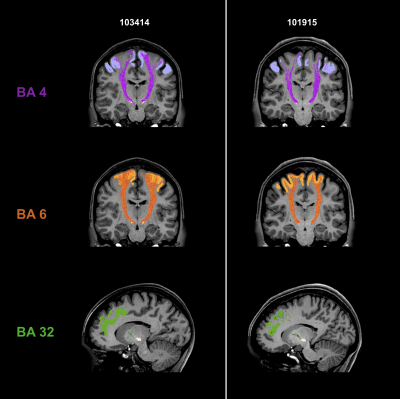 |
Functional organisation of the hyperdirect pathway by in vivo structural connectivity imaging in healthy humans at 3T
Gizem Temiz, Chantal François, Carine Karachi, Sonia Pujol, Eric Bardinet, Sophie Sébille
The goal of this study is to investigate the anatomo-functional organization of the hyperdirect pathway between the subthalamic nucleus (STN) and the cortex in humans. We identified motor, limbic and associative areas of the whole cortex. We used DWI from 30 healthy subjects and probabilistic tractography between the STN and 39 cortical areas. The motor part of the hyperdirect pathway was found predominant compare to the limbic and above all the associative parts.
|
|
1660.
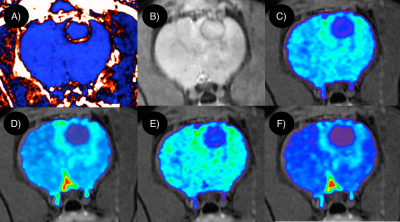 |
Utility of Advanced Diffusion Models in Assessing Abscess Structure
Robert Wujek, Mona Al-Gizawiy, Kathleen Schmainda, Rodney Willoughby
MR imaging is commonly used in the diagnosis and monitoring of cerebral abscess, especially diffusion weighted imaging. However, the use of advanced diffusion models has yet to be seen with respect to this type of brain mass. The stretched-exponential, intra-voxel incoherent, and kurtosis diffusion models not only generate diffusivity coefficients, but also other parameters that may prove valuable in properly understanding the structure and progression of such lesions.
|
|
1661.
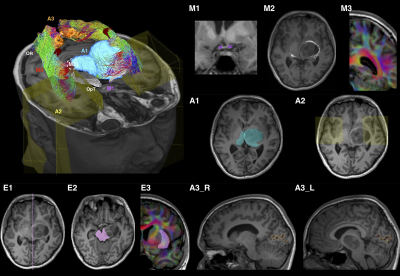 |
Optic radiation tractography in pediatric brain tumor and epilepsy surgery: a test-retest reliability assessment of the tractography method
Joseph Yang, Richard Beare, Michelle Wu, Sarah Barton, Charles Malpas, Vicki Anderson, Wirginia Maixner, Marc Seal
Existing optic radiation (OR) tractography methods lack pediatric and surgical focus. We proposed a clinically feasible tractography framework and examined its test-retest reliability using both the preoperative and intraoperative MRI from eight pediatric epilepsy and brain tumor patients. Good to excellent intra- and inter-rater reproducibility was demonstrated in the assessments of all diffusion and morphological track metrics. The reconstructions closely resembled classic anatomy. All OR images were used to assist surgical planning and resection. Postoperatively, no patient had new visual field deficits. Our tractography method generates reproducible OR images that can be safely implemented in routine, non-emergency pediatric neurosurgical settings.
|
|
1662.
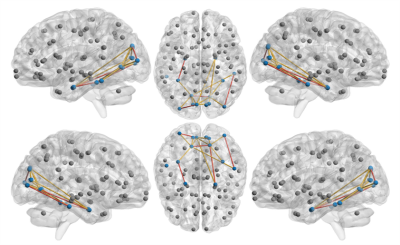 |
Impaired executive and visual network integrity in patients with Parkinson’s disease and psychosis: A structural connectome based study
Abhishek Lenka, Apurva Shah, Jitender Saini, Pramod Kumar Pal, Madhura Ingalhalikar
Psychosis manifested as formed visual hallucinations is one of the debilitating non-motor symptoms of Parkinson’s disease (PD), the patho-physiology of which remains unclear. To gain insights into the neural correlates of psychosis in PD this study analyzed the structural connectomic sub-networks of visual, executive and memory circuits between patients with PD and psychosis (PD-P), PD without psychosis (PD-NP) and controls (HC). When PD-P and HCs were compared, a global connectivity deficit was observed in the visual and executive circuits and multiple connections within the visual network demonstrated significantly lower connectivity in PD-P. Such changes were not observed in PD-NP vs. HCs.
|
|
1663.
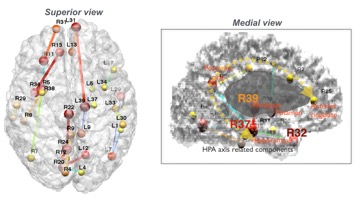 |
A comparison of different brain connectivity markers for classifying Gulf-war illness
Bang-Bon Koo, Kimberly Sullivan
Gulf War Illness (GWI) represents a cluster of multi-system chronic symptoms experienced by a third of veterans who served in the Gulf War. The exact cause of GWI remains unknown and efforts directed towards developing treatments have been hampered by the lack of meaningful objective biomarkers of the illness. Combining machine learning technology to brain connectivity imaging may allow for better understanding of the complex pathobiology of GWI. Choosing optimal imaging index should be a first step to maximize its classification performance.
|
|
1664.
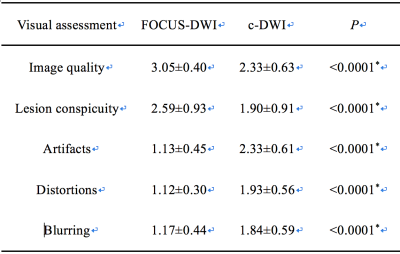 |
DWI assessment of the optic nerve and chiasma of acute optic neuritis: Advantages in field-of-view optimized and constrained undistorted single shot (FOCUS) method
Yuan Tian, Lin Ma, Gang Liu, Mengyu Liu, Mingge Li
In the current study, we evaluated the performance of the field-of-view optimized and constrained undistorted single shot (FOCUS) DWI in assessing the optic nerve and chiasma abnormalities of acute optic neuritis. Visual assessment was obtained for the FOCUS-DWI and the conventional-DWI (c-DWI). We found that FOCUS-DWI provided better visual assessments of the optic nerve and chiasma abnormalities in acute optic neuritis (AON), with much reduced blurring effects and geometric deformations. It might indicated that the FOCUS-DWI would improve the diagnostic accuracy and prognosis evaluation in AON.
|
|
1665.
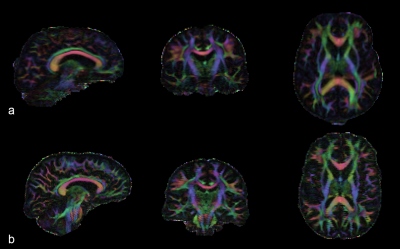 |
A Method to Quantitatively Assess and Compare Diffusion MRI Protocols between MR Systems
Samuel Hurley, Alan McMillan
MRI systems and protocols capable of achieving diffusion measurements with comparable imaging parameters and equal or better performance to the Human Connect Project (NCP) acquisitions will enable studies in additional populations or patient groups to leverage existing HCP data as control data, decreasing costs and increasing statistical power of findings. To evaluate new MRI systems and potential protocols, we present an automated and quantitative method for evaluation of diffusion imaging performance from in-vivo data, use this method to evaluate the performance of a dMRI protocol acquired in a prototype wide bore 3T MRI system.
|
|
1666.
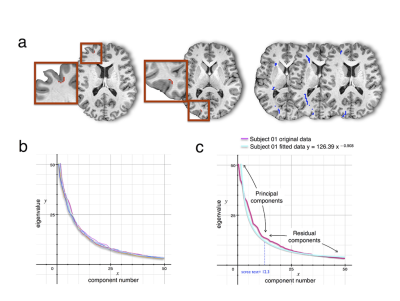 |
Tractography based parcellation of the frontal lobe: reproducibility & functional significance.
Michel Thiebaut de Schotten, Marika Urbanski, Leonardo Cerliani, Emmanuelle Volle
Dividing the brain based on structural connectivity is a challenge that we circumvented using the principal component analysis framework. By doing so, we reliably divided the frontal lobe into 12 areas across datasets and participants. Additionally, these areas showed neat functional specificity as defined by functional magnetic resonance imaging.
|
|
1667.
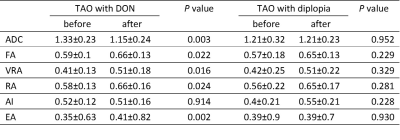 |
Application of DTI on hyroid-associated ophthalmopathy (TAO) with Dysthyroid Optic Neuropathy (DON) or diplopia patient after intravenous methylprednisolone strategy.
ping liu, jing zhang
The pathogenesis of DON and diplopia is totally different. This study use the MRI-DTI on DON and diplopia patients with good therapeutic efficacy, the multiple DTI parameters of optic nerve were calculated and assessed. The final results furtherly confirmed this difference. And the statistical difference of DTI parameter changes in DON patients validate the DTI can exactly, objectively and reliably detect the microstructure and functional repair of optic nerve after iv MP therapy.
|
|
1668.
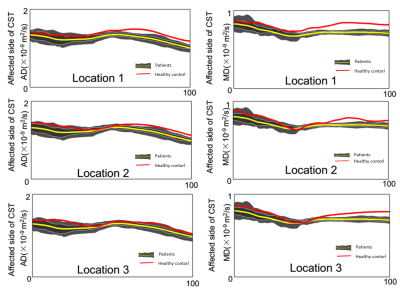 |
Automated fibre quantification predicts early Wallerian degeneration of the CST after acute ischemic stroke
Min TANG, Wei DI, Xin ZHANG, Jie GAO, Xiaoling ZHANG, Zhizheng ZHUO, Xia ZHE, Dongsheng ZHANG, Xuejiao YAN
This study aimed to observe the microstructural alterations in corticospinal tract (CST) after motor pathway infarction and predict early Wallerian degeneration based on automated fiber quantification (AFQ). 53 patients with first-onset stroke in motor pathway and 29 health age-matched controls were enrolled. FA, MD, AD and RD values were significantly reduced on lesions of the affected side, while DKI values (MK, AK and RK) exhibited significant increase. AFQ was performed to identify differences on the whole CST pathway in the affected side between control and patient group. AD and MD values in CST of the affect side were significantly higher than them in healthy control. The findings of AD and MD have the same pathological changes on the affected CST pathway no matter the primary stroke lesions located in any regions (brainstem, posterior limb of internal capsule or above centrum semiovale). Our findings suggest that AFQ has the potential to detect the early Wallerian degeneration in the central nervous system in vivo after the first 24 hours in stroke.
|
|
1669.
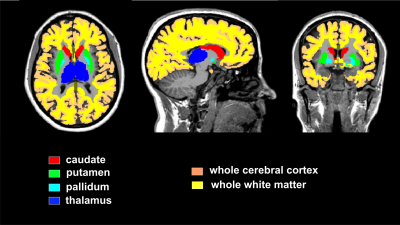 |
Diffusion tensor imaging (DTI) in patients with cystic fibrosis
Petr Bednarik, Alena Svatkova, Silvia Mangia, Christophe Lenglet, Antoinette Moran, Amir Moheet
Cystic fibrosis (CF) is the most common fatal autosomal recessive disorder in Caucasians. As the effects of CF on the brain structure remain unexplored, we piloted initial MRI investigations of brain structure by diffusion weighted imaging in CF and cystic fibrosis related diabetes (CFRD), a common complication in CF patients. Diffusion metrics were obtained in selected white and gray matter regions of 5 healthy controls (HC) and 5 CF patients with CFRD. Diffusion metrics of deep gray matter structures appeared to differ between patients with CF and HC, possibly related to increased iron deposition, warranting more comprehensive MRI investigations in larger cohorts of patients.
|
|
1670.
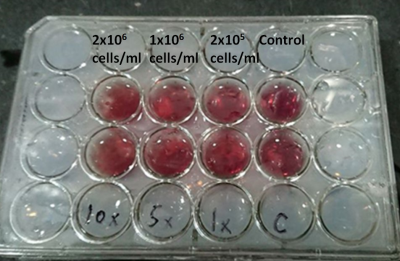 |
DW-MRI in assessment of 3D Cell Culture
Jui-Heng Lin, Hao-Chun Peng, Shao-Chieh Lin, Yi-Jui Liu, Ruey-Hwang Chou, Ke-Sin Yan, Tan-Wei Liao, Chia-Wei Lin, Chao-Chun Lin, Wei-Ching Lin , Wu-Chung Shen
In extracellular and intracellular space, the Brownian motion of water is restricted by organelles, cellmembranes, and extracellular fibers. DWI is sensitivity to microscopic motion, which is due to Brownian motion of water molecules. In this study, 3D cell culture with hydrogels ECM was used to investigate whether DWI may provide information on these microenvironmental parameters and the microenvironment-associated metastatic propensity of tumors. Our results demonstrated DW-MRI may provide the potential biomarkers on the change of microenvironment in the application of 3D cell culture experiment.
|
|
1671.
 |
Structural and functional brain connectivity highlights in neurosensorial profound deafness
Pedro Henrique Rodrigues da Silva, Antonio Carlos Santos Senra Filho, Karol Dell Ducas Senra, Renata Ferranti Leoni, Luiz Otavio Murta Junior, Antonio Carlos dos Santos
The absence of auditory stimuli for a long period leads to modifications in brain structural and functional connectivity. However, the relationship between the brain changes and neurosensorial hearing loss is not fully clarified. In this study we considered a group of subjects with pre-lingual congenital deafness and analyzed their structural and functional connectivity. Our results suggest that auditory input deprivation not only alters the activity of sensory areas but also reshape the structural and functional organization of cognitive-related networks. These findings can be instructive to clinical practice.
|
|
1672.
 |
Novel Multi-band accelerated, Reference-less, Multifaceted Icosahedral and Multishell Diffusion MRI Protocol for human whole brain clinical applications
Khader Hasan, Refaat Gabr, John Lincoln, Ponnada Narayana
We describe a comprehensive multishell and multifaceted icosahedral diffusion MRI protocol that enables whole brain coverage in less than 10 minutes using multiband (MB) technology at 3 T. We show the protocol utility in providing estimates of blood fraction, extent of CSF-contamination, diffusion tensor and kurtosis derived measures including fractional, axonal water fraction and extracellular tortuosity. The diffusion gradient encoding is based the Icosa6 and Icosa15 sets forming the Icosa21 for additional quality assurance. In this report we describe the protocol, show feasibility and utility for mapping a host of useful quantitative measures in the same session without repeated scans.
|
|
1673.
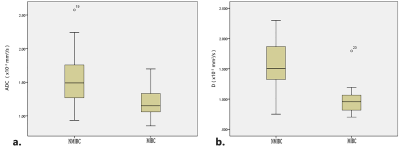 |
Role of intravoxel incoherent motion diffusion-weighted imaging in the assessment of invasiveness for bladder cancer
Fang Wang, Guangyu Wu, Weibo Chen
The degree of bladder wall invasion by bladder cancer determines the clinical management, for muscle invasive bladder cancer (MIBC, Stage T2 or more) recommended neoadjuvant chemotherapy before radical cystectomy and non-muscle invasive bladder cancer (NMIBC, Stage T1 or lower) treated with transurethral resection (TUR). Thus, differentiating NMIBC from MIBC using preoperative imaging plays a crucial role in clinical practice.
|
|
1674.
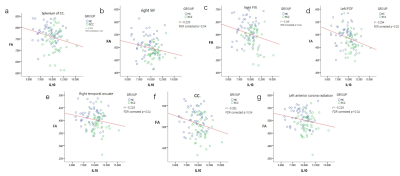 |
Relationship between peripheral Interleukin 10 and white matter integrity in stable medicated schizophrenia
Gui Fu, Dongsheng Wu, Wenjing Zhang, Jieke Liu, Yuan Xiao, Li Yao, Jiaxin Zeng, John Sweeney, Su Lui
To our knowledge, this is the first time to study the association between plasm IL10 level and WM disruption in stable medicated schizophrenia using diffusion tensor imaging (DTI). The present study provided empirical evidence that dysregulation of inflammation contributes to anatomical dysconnectivity in schizophrenia.
|
|
1675.
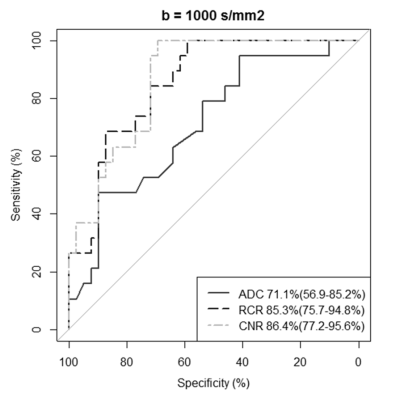 |
Prediction of histological grade of hepatocellular carcinoma using quantitative diffusion-weighted magnetic resonance imaging: a retrospective multi-vendor study
Yoshio Kitazume, Yusuke Ogihara, Ukihide Tateishi
Eighty-three patients with 100 histologically diagnosed hepatocellular carcinomas (HCCs) who preoperatively underwent diffusion-weighted (DW) imaging at any of 6 institutes were retrospectively studied. Receiver-operating characteristic analysis revealed that quantitative measurements such as the relative contrast ratio (RCR) and the contrast-to-noise ratio (CNR) between lesion and liver parenchyma on DW images were superior to the apparent diffusion coefficient (ADC) in predicting poorly differentiated HCCs, and intraclass correlation coefficients for the RCR tended to be greater than for the CNR and the ADC.
|
|
Diffusion MRI: Microstructure
Traditional Poster
Diffusion
Tuesday, 19 June 2018
| Exhibition Hall 1676-1688 |
08:15 - 10:15 |
|
1676.
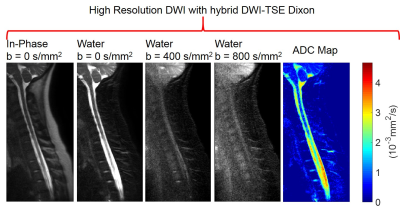 |
Diffusion Weighted Imaging with uniform fat suppression using a Modified Dixon based Single Shot Turbo Spin Echo
Xinzeng Wang, Holger Eggers, Marco Pinho, Ivan Pedrosa, Robert Lenkinski, Ananth Madhuranthakam
Diffusion weighted imaging using single-shot turbo spin echo (DW-SShTSE) with Dixon showed uniform fat suppression without geometric distortions, compared to DW-EPI and DW-SShTSE with spectrally selective fat suppression (SPIR). However, the phase insensitive preparation used in DW-SShTSE reduces the SNR by half, impeding the robustness of Dixon reconstruction. In this work, we developed a hybrid DW-SShTSE, where the b=0 s/mm2 image was acquired without the phase insensitive preparation for improved SNR. This combined with modified acquisition order improved the robustness of fat/water separation and generated diffusion-weighted images of the cervical spine with improved spatial resolution.
|
|
1677.
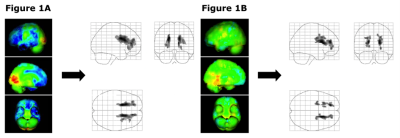 |
Diagnostic value of diffusion tensor imaging and positron emission tomography in early stages of frontotemporal dementia
Julia Krämer, Gero Lueg, Jan-Gerd Tenberge, Patrick Schiffler, Alexis Vrachimis, Matthias Weckesser, Christian Wenning, Andreas Johnen, Matthias Pawlowski, Sven Meuth, Thomas Duning
The study intended to investigate the sensitivity of DTI and FDG-PET in 30 patients with early behavioral variant frontotemporal dementia (bvFTD) despite inconspicuous conventional MRI. Based on individual FDG-PET data analysis, 20 patients were rated as bvFTD “typical” with bifrontal/ bitemporal hypometabolism (bvFTD/PET+) and 10 patients as “not typical/normal” (bvFTD/PET-). DTI voxel-based group analyses revealed bifrontal/ bitemporal microstructural degeneration in all patients. However, individual DTI data analysis revealed alterations in only 14%. Neuropsychological symptoms were associated to DTI and FDG-PET identifiable cerebral changes. Summarising improvement of individual DTI analysis tools is necessary to make this technique applicable for clinical routine.
|
|
1678.
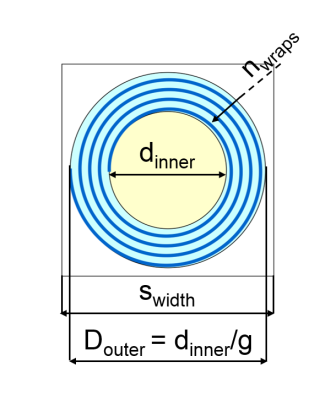 |
Monte Carlo simulations of diffusion in myelin spirals: Impact on diffusional water exchange
Lorenza Brusini, Gloria Menegaz, Markus Nilsson
How does the myelin structure impact water diffusion? The answer is still not clarified but is important for interpreting diffusion MRI in conditions with altered myelin structure such as neurological disorders or developing brain. Myelin is sometimes modelled as permeable to explain exchange between compartments. This work investigates the impact of the spiralling nature of myelin on water exchange, until now only indirectly explored in one case. Findings emphasized that small axons and low number of myelin wraps lead to exchange times shorter than a second, which can be assessed at clinical scanners.
|
|
1679.
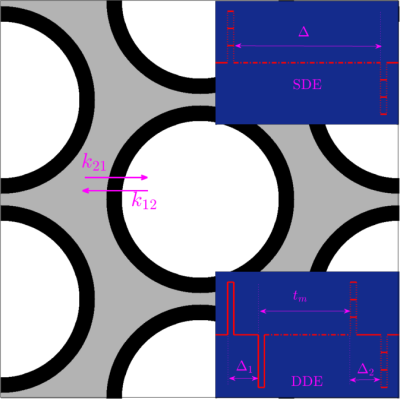 |
Measuring water exchange using cumulant expansions
Lipeng Ning, Markus Nilsson, Carl-Fredrik Westin, Yogesh Rathi
Diffusion MRI (dMRI) can provide important information about water exchange between different tissue compartments. In this abstract, we introduce a generalized model to measure the exchange rate using arbitrary gradient sequences. We present a unified theory that incorporates water diffusion and exchange as a stochastic diffusion-exchange process. Our work for the first time allows to compare different diffusion sequences and allows to determine the optimal experimental configurations to measure the exchange rate. In the most common situation with single- or double-diffusion encoding (SDE, DDE) sequences, our theory shows that DDE is more sensitive to water exchange at short time scale. We validate our theory using Monte-Carlo simulations.
|
|
1680.
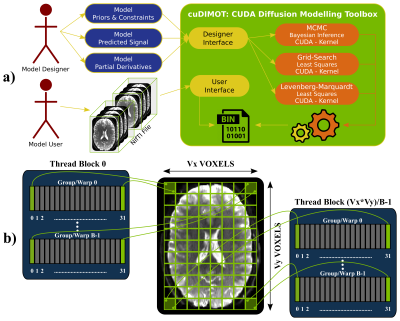 |
Using GPUs to accelerate computational diffusion MRI: From microstructure estimation to tractography and connectomes
Moises Hernandez-Fernandez, Istvan Reguly, Saad Jbabdi, Mike Giles, Stephen Smith, Stamatios N. Sotiropoulos
The great potential of computational diffusion MRI (dMRI) relies on indirect inference of tissue microstructure and brain connections, as modelling and tractography frameworks map diffusion measurements to neuroanatomical features. This mapping however can be computationally expensive, particularly given the trend of increasing dataset sizes and/or the increased complexity in biophysical modelling. We present here a number of frameworks for accelerating dMRI computations using Graphics Processing Units (GPUs), for both microstructure estimation and tractography/connectome generation. We show that despite differences in challenges for parallelising these problems, GPU-based designs can offer accelerations of more than two orders of magnitude.
|
|
1681.
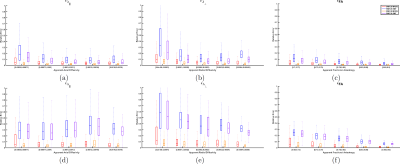 |
On the estimation of the apparent bundle-wise diffusivity profiles for axon damage detection
Ricardo Coronado-Leija, Alonso Ramirez-Manzanares, Jose Marroquin, Luis Concha, Gilberto Rojas-Vite, Ramsés Noguez-Imm
To estimate the physical features of intra-voxel axon bundles in the detection of axon damage it is important to compute bundle-wise apparent diffusivities. There is a first family of methods that factors-out the effects of the orientation-dispersion under a convolution model (e.g. Spherical Mean), and a second family that associates the diffusivity properties with specific orientations (e.g. Gaussian-Mixture-Models). Here we demonstrate that only the second family provides bundle-wise apparent diffusivities, and thus it provides the useful information for clinical applications. This is demonstrated on a broad synthetic validation as well as on ad-hoc rat ex-vivo phantom with a damaged bundle.
|
|
1682.
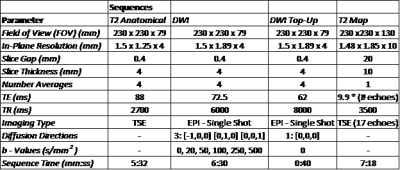 |
Diffusion-Weighted MR Imaging of the Parotid glands in healthy volunteers before and after a gustatory stimulation to quantify relative function
Matthew Birkbeck , Fiona Smith, Andrew Blamire
Diffusion Weighted MR Imaging has been used to quantify the function of parotid glands. Clinically gland function is measured using Scintigraphy, but MR offers a non-invasive, non-ionising alternative to this method. A DWI sequence for investigating parotid gland function is presented and tested in five healthy volunteers scanned on two occasions. We used four parameters to represent gland function: perfusion fraction (fv), apparent perfusion coefficient (ADCperfusion), diffusion fraction (fd) and apparent diffusion coefficient (ADCdiffusion). Statistically significant changes were observed in fv, fd and ADCdiffusion in volunteers. Results indicate a normal range for these parameters.
|
|
1683.
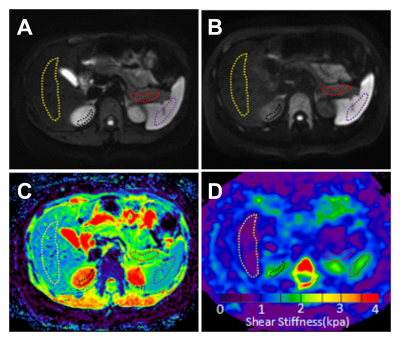 |
DWI virtual MR elastography of the upper abdominal organs in healthy volunteers
Min Wang, Yu Shi, Xiaoqi Wang, Yanqing Liu, Ruoyun Ji, Lizhuo Cang, Qiyong Guo
Le et al1recently found that apparent diffusion coefficient (ADC) calculated from 2 key b values (“shifted ADC”, or sADC) can be directly and quantitatively represent healthy liver stiffness and be compared with results obtained by standard MR elastography (MRE). In this study, we found that there is a strong linear relationship between sADC and stiffness in both liver and pancreas, and a weak relationship in spleen, but no coherence in kidney in healthy volunteers.
|
|
1684.
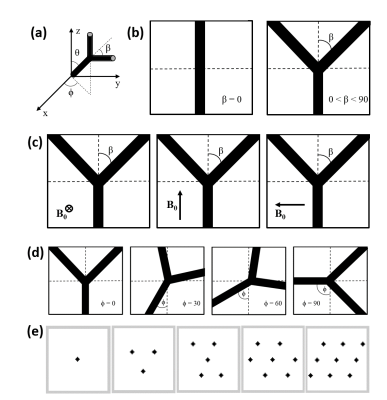 |
Investigation of diffusion, susceptibility, and vessel morphology effects on R2 in characterizing normal and tumorous vasculature using simulations
Mohammed Salman Shazeeb, Jayashree Kalpathy-Cramer, Bashar Issa
Brain vasculature is conventionally represented as straight cylinders when simulating BOLD contrast effects in fMRI. In reality, the vasculature is more complicated with branching and coiling especially in tumors. We applied a cylinder fork model to reflect the bifurcation, rotations, and size of vessels and performed simulations to study the effect of the rotation angle (?) on R2 at different bifurcation angles, vessel diameters, diffusion rates, and susceptibility values. This model clearly showed an R2 dependence on ?, which could potentially be used, in addition to R2*, as a tool to differentiate between normal and tumor vessels.
|
|
1685.
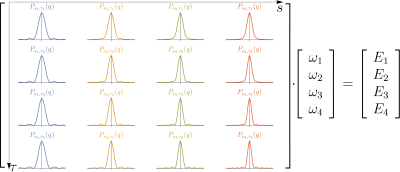 |
Obtaining the barrier distribution in the micro-structure from diffusion spectra
Carlos Castillo-Passi, Gabriel Varela-Mattatall, Claudia Prieto, Carlos Sing-Long, Pablo Irarrazaval
Inspired in the solution of the diffusion equation in the restricted case, we propose to express the diffusion $$$q$$$-space information in a restricted basis. This representation allows to obtain the distribution of barriers separations, thus providing useful information about the micro-structure. Previous methods used multiple Diffusion Spectrum Imaging (DSI) images with different diffusion times, which is impractical to characterize barriers in multiple directions. Our method proposes to obtain the barrier distribution with only a single DSI image. Furthermore, the model does not use a strong assumption for the geometry of the barriers (or axons) nor for the probability distribution of the barrier separation.
|
|
1686.
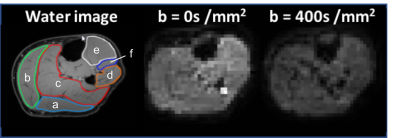 |
Increasing Mixing Time in STEAM-DTI Enhances Inter-Muscle Heterogeneity Patterns in the Lower Leg of Healthy Subjects
Celine Baligand, Thom Veeger, Jedrek Burakiewicz, Melissa Hooijmans, Jan Verschuuren, Erik Niks, Hermien Kan
Hereditary muscular disorders are characterized by progressive skeletal muscle wasting and weakness. Although these diseases are caused by ubiquitous genetic mutations, the symptoms appear at different rates in different muscles. We investigated the differences in microstructural properties of different muscles of the lower leg in healthy subject using STEAM-DTI with varying diffusion times at 3T. We identified a characteristic pattern of differences in fractional anisotropy and diffusivity in healthy muscles than can serve as a knowledge base for future studies on disease progression in muscular disorders.
|
|
1687.
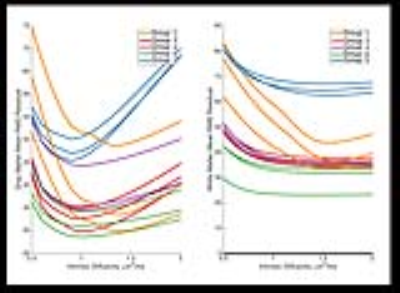 |
Residual analysis reveals variation of the intrinsic diffusivity throughout the brain in neurite orientation dispersion and density imaging (NODDI)
Jose Guerrero, Nagesh Adluru, Steven Kecskemeti, Richard Davidson, Hui Zhang, Andrew Alexander
NOODI and its widely used estimation toolbox assume the intrinsic diffusivity to a fixed value suitable for healthy adult brains. For broader applicability of the model in neurological diseases it is important to understand the validity of assumed fixed intrinsic diffusivity. Using multi-shell diffusion data we investigated the variability of estimated NODDI indices as well as the model residuals with respect to variations in intrinsic diffusivity. The results suggest significant differences between optimum intrinsic diffusivity for white and gray matter regions as derived from intrinsic diffusivity values that generate smallest model residuals. The variability analysis indicates appreciable differences in the estimated parameters in the range of probable diffusivities predicted by the residual analysis.
|
|
1688.
 |
Fitting MAP-MRI in 2 shell DWI Datasets using Model-based Extrapolation
maryam afzali, Sharlene Newman, Eleftherios Garyfallidis, Hu Cheng
We showed that three shells are sufficient to result in good approximations of MAP-MRI indices from numerical simulation. We used multiple compartment microstructure models to fit the two shell data and extrapolate the third shell with a higher b-value. We compared the performance of two models, NODDI and NODDI with fiber crossing (NODDIx), on the Human Connectome Project (HCP) DWI data. NODDIx showed improvement in the white matter with extrapolation but NODDI did not. Both NODDI and NODDIx failed to improve the results in the gray matter. Our approach also provides a new mechanism in validating or comparing microstructure models.
|
|
| Back |
| The International Society for Magnetic Resonance in Medicine is accredited by the Accreditation Council for Continuing Medical Education to provide continuing medical education for physicians. |








































































































































